The application is now available for the Summer 2024 REU on Sustainable Land and Water Resources. Read about this year’s projects here and apply here.
Scroll down in the blog to see what our participants did last summer!
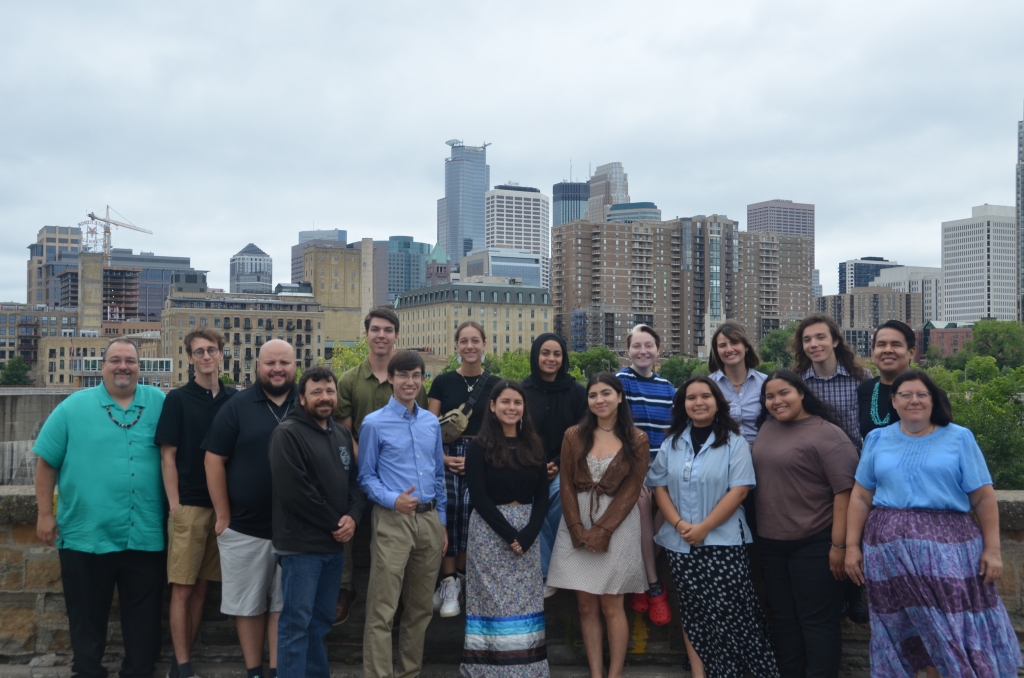

This week, team Zaaga’igan had a busy schedule. Right alongside working on posters and project literature, they also did a variety of activities with Fond du Lac professionals. This week was very informational and held a great importance for us because of how much we were able to get involved with the community.
This started on Wednesday, when the team met with natural resource manager Tom Howes to attend the Sandy Lake Tragedy Memorial Ceremony. People from multiple tribe affiliations came as the event had sacred and historical value for all the Ojibwe people. This is because it held many origins for how the Ojibwe negotiated with the US government for their reservation territory. Only after the US government held back vital supplies they promised to natives, something that caused the deaths of hundreds, and the odyssey of an Ojibwe delegation led by Chief Buffalo across the Eastern US to get to Washington DC did the Ojibwe finally get some leverage in their treaty negotiations. Team Zaagai’gan was fortunate to be invited and canoe with everyone else to begin the ceremony.
On Thursday, Team Zaagai’gan went to a council meeting called a VOIGT conference. This was held at a meeting room in a casino building for all the tribes around the region where council members were being proposed new science projects or updates on them by members and scientists working for reservations. This was a very immersive experience and allowed us the opportunity to introduce the start of our projects to the council members after introducing ourselves to them. It was also very interesting to see how the meetings themselves ran, and the variety of problems and topics that were addressed.
On the next day, Friday, Team Zagaa’igan was back on the reservation. It was also quite the adventure for this day as well because we worked with Mike Schrage to learn about the wolf tracking project and how the cameras were prepared to record their movements. On this day we were also able to drive a small four-wheeler, buggy-type of vehicle that helped us get to a few cameras stowed in a part of the reservation for the cameras enshrouded by tall grass, thickets, and many buzzing insects. We could see the photos the cameras took right after our mentor extracted their memory cards. From these memory cards, we saw recordings and pictures of people trail running by them, bears, turkey, wolves, and ourselves from getting out of the car and walking up to the camera. It was also a bit of maintenance work too if there were trees or foliage nearby the camera, so our mentor brought a weed wacker and large clippers to trim anything that could trigger or obstruct the view of the forest cameras.
Following this wildlife tour, Mike took us out to see Rice Portage Lake, which was coming along very nicely. The rice looks very healthy and the community seems to be very excited for the upcoming harvest.
Finally! After an eventful weekend at Lake Superior visiting the Duluth team, I have been hard at work conducting the last of my experiments and processing data this week.

The past few weeks, I have been researching about the important role of clay not just within the energy industry, but also in environmental remediation efforts, such as soil and land management, geosynthetic sealing barriers, and groundwater protection below roads and railways. The experiments aim to investigate the impact of groundwater, with varying flow rates and salinity, on clay migration and soil erosion. With the help of my grad mentor William, we fabricated microfluidic models simulating the porous structure of clay-rich sandstone, which we initially saturated with a clay called bentonite. Observing the interactions using a confocal microscope, the data revealed that the shear stress needed to erode clay initially increased, then decreased with higher water salinity. Additionally, we observed the bentonite’s unique ability to expand and contract in response to water, which implies that there is a threshold for optimal soil erosion and oil recovery. This led to me to some interesting conversations with my mentor Dr. Yang and grad student Soukaina about the properties of swelling clay.

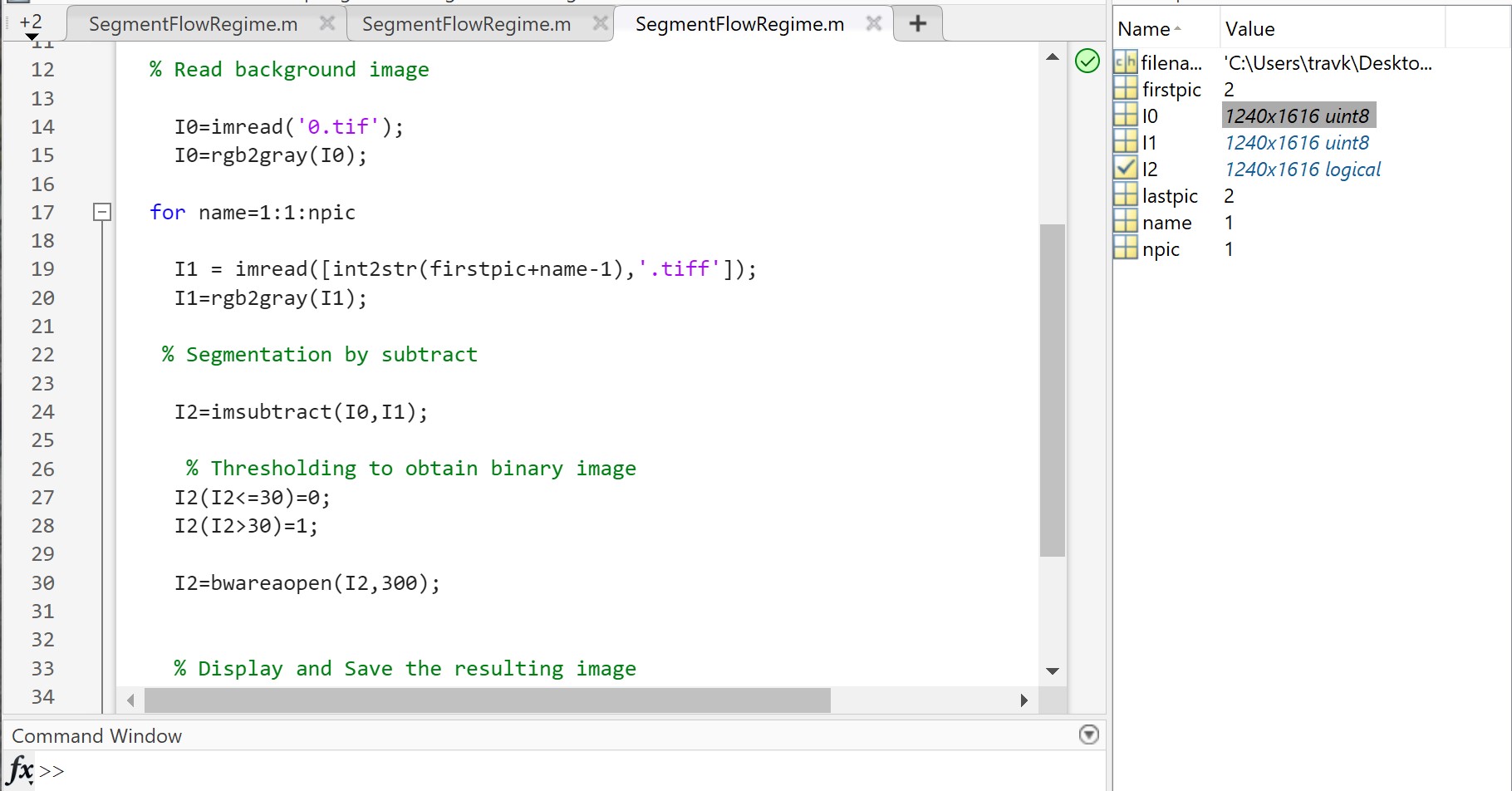
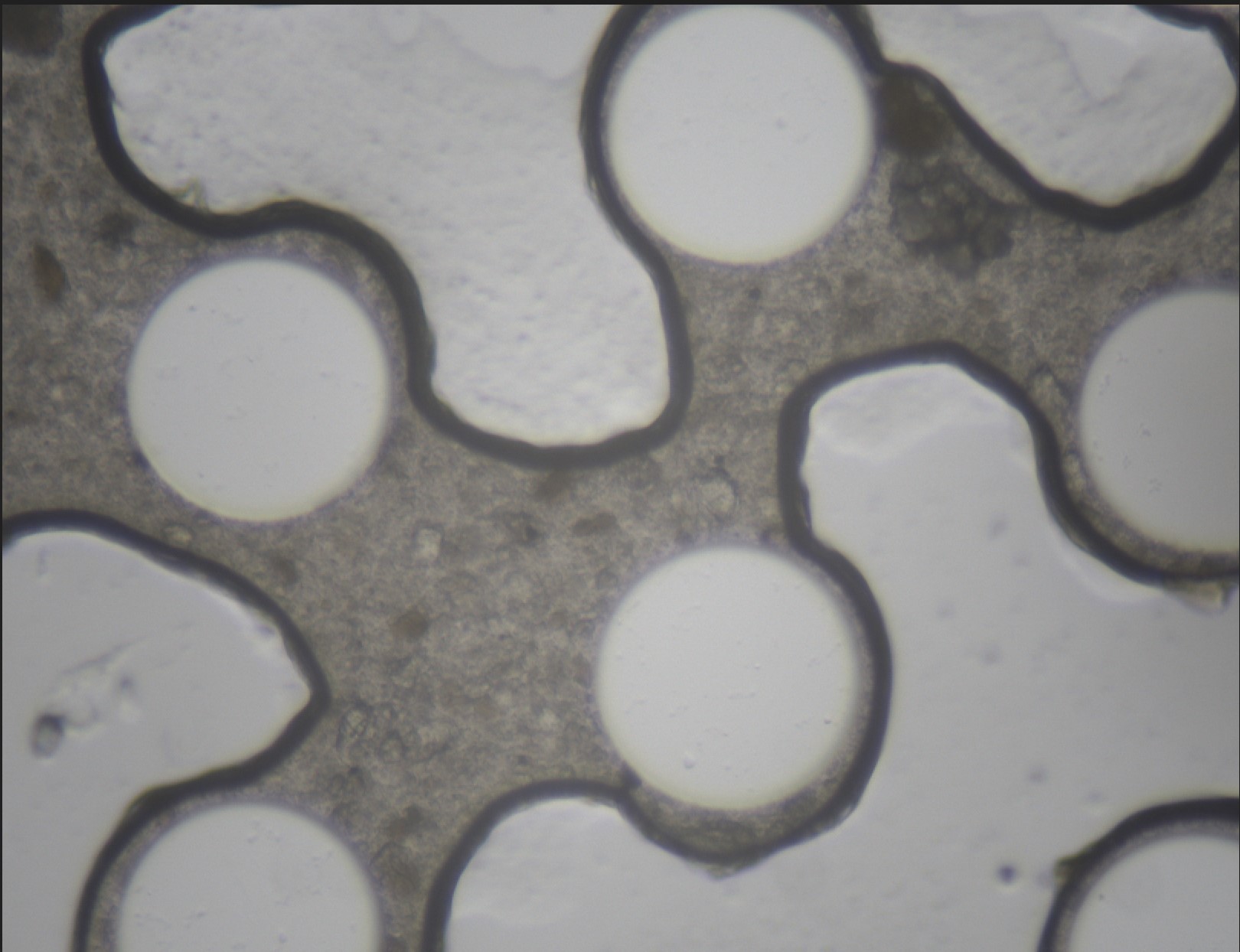
On another note, the Mississippi River has been truly breathtaking. Watching the sunset from the East River Parkway is totally worth the walk (or bike). If you are lucky, you can find a serene place to catch a bass from the shoreline (I caught a few last weekend). If anyone knows how to catch a pike or other northern fish, let me in on the secret!

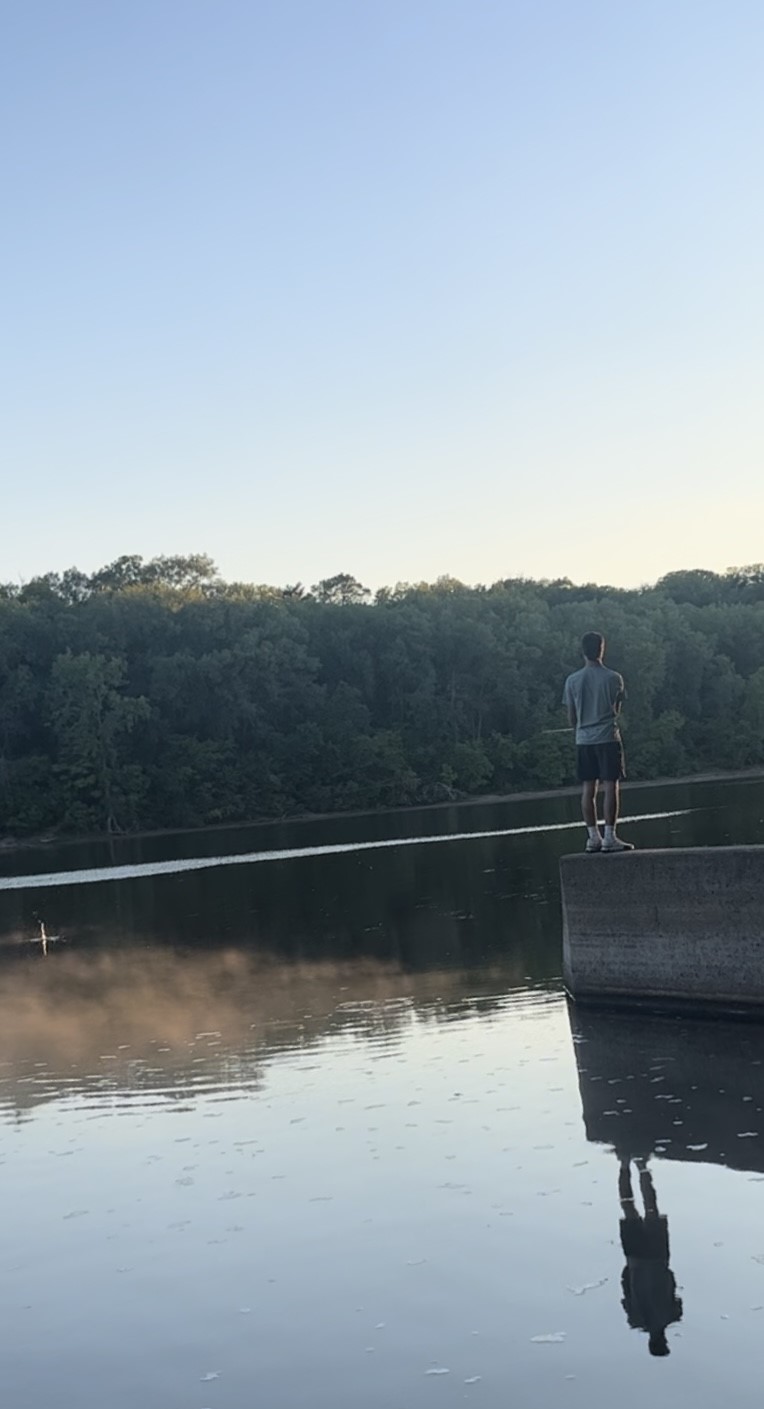
This week was a never ending one for Team SPAW filled with plenty of highs and lows. We spent much of our time editing our Storymaps and refining our results. Team GPR originally planned to fly a drone over the cemetery on Tuesday but due to a fire in the area, plans were canceled. On Wednesday we had a much needed post-work kayaking trip at McDonald Lake.
Dennis noted that the lake was really low compared to previous years, consistent with what we’re seeing at Flathead Lake. Friday we took our workday to Tony’s back deck and enjoyed some time working outside with his cats. Lizzy also had an hour long conversation that day with a crop consultant which led her on a wild goose chase calling other helpful agronomists.
On Saturday, we made a trip to Polson for the annual Cherry Festival! Sylvie and Lizzy made a great showing at the cherry spitting competition, though the 40 feet record was hard to beat.

Today it’s also been pretty smokey with nearby fires. The sun is red!

Uff da! It has been quite the busy week for the Urban Nature group. Long days in the field under the sun has our team wiped! Nonetheless, Frankie and Aidan have been digging deeper into their projects and working on drawing some conclusions from their research.
Frankie was out in the field this week with mentors Xiating and Lucy to help check on the sap flux sensors and throughfall collectors. The team also got the opportunity to meet with journalist Andrew Hazzard to discuss the work they’ve been doing across the city! Later in the week, Frankie worked in the lab with researcher Grace Neumiller performing an SRP analysis on the throughfall collected from the sites. She has also been continuing to analyze her ICP-OES results from her foliar samples. She was very excited to present her findings to the LTER team and get their feedback!
Aidan was running around like a chicken with its head cut off this week as he continued to collect foliar samples in the 95 degree weather. He was happy to continue seeing agreeable water potential measurements with mentor Jeannie and has begun the analysis and presentation components of the project. Looking ahead to the final weeks, Aidan is hopeful for cooperative weather, quality data, and a cohesive final deliverable.
“This week concludes the 3 week germination period for the seeds that were growing in the petri dishes. I conducted a final count of seeds that germinated and those that did not. I have begun to analyze this data to compare the differing treatments of temp, over-wintering periods, and desiccation. Preliminary data analysis is being done to check reliability and figures are being made of the different responses to the treatments. I am using R Studio to conduct a chi-square test using the TZ test results to check the viability of the different populations, Hay Creek and Dead Fish.
“This week I have been trying to interpret my results by looking for trends in the graphs I made and doing some statistical analysis. I ultimately came to the conclusion that: “Every lake is unique in how it responds to human-influenced sedimentation events (like white settlement and logging). Detailed understandings of each lake and impacts on sedimentation are necessary in order to understand how Manoomin (Ojibwe)/Psiη (Dakota), or wild rice, may be impacted in the future from similar events, as well as unprecedented changes related to climate change.” I have also been working on my poster and sending out drafts of my abstract and poster to collaborators for feedback!”
-Saheli
Other activities our group participated in this week was a tour of Cara Santelli’s lab, 2 zooms to meet alumni and learn about career paths, and a plant ID workshop led by the College of Food, Agricultural and Natural Resource Sciences department in partnership with the Minnesota Department of Natural Resources.
This week we were in Northern Wisconsin on the Lac du Flambeau reservation meeting with our collaborators and conducting fieldwork. The hydrological side of our fieldwork involved collecting surface water samples and collecting measurements (water depth for example) in order to calibrate our piezometers and stream gauges.
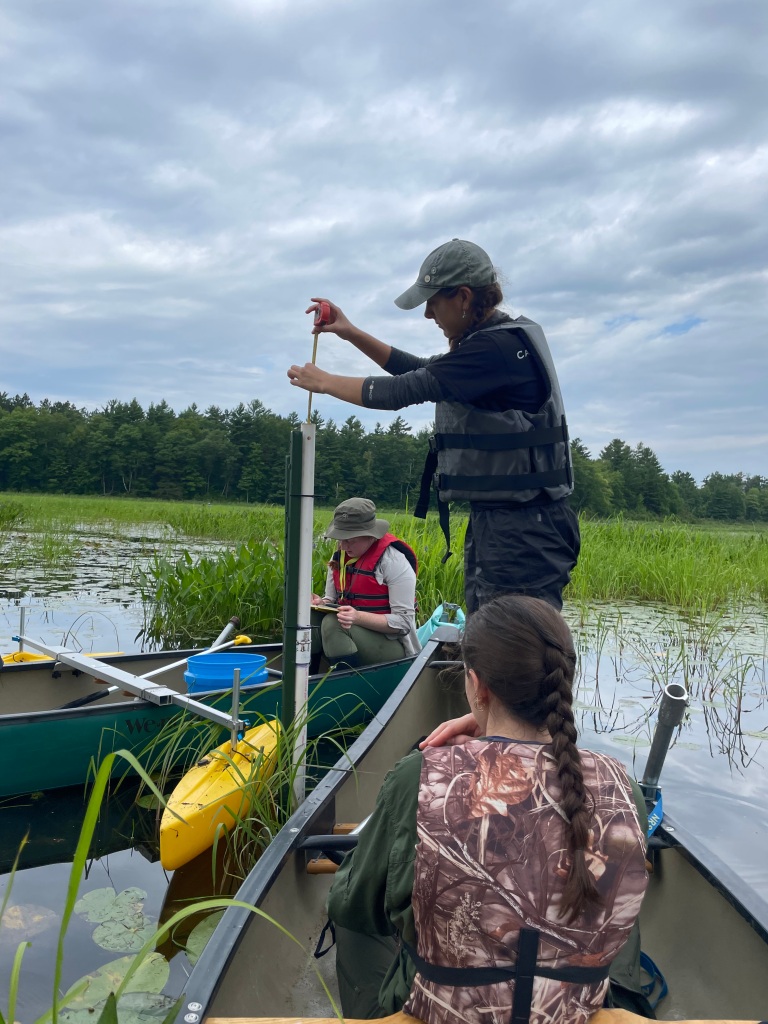
We also conducted wild rice stalk density surveys, which involved counting stalks, taking measurements of water and muck depth, recording observations of other plants, and taking measurements of representative wild rice plants within each 0.5 square meter section of the lake (sections random chosen, approximately 20 per lake/river).

We camped all week, braving a thunderstorm and TONS of rain, and rounded out the trip with a meeting with our collaborators where Crystal Ng presented on research updates from the UMN Manoomin collaborative team. We discussed other direction to look into as well! It was wonderful to enjoy the wild rice and nature from canoes while conducting fieldwork. And we learned so much from our collaborators.

The Urban Nature group had a very exciting week 6! The team hosted a field talk with approximately 40 members and associates of the Minnesota Stormwater Research Council (MSRC) to discuss the research projects that have been taking place across St. Paul parks.
This week, Frankie got to collect more foliar samples from the four parks in St.Paul to get another set of data analyzing the dry deposition of heavy metals. She spent a lot of time in the lab with mentor Lucy Rose washing the samples and getting them ready for ICP analysis. They also collected a good amount of throughfall at each site this week, so they were able to perform a phosphorus concentration analysis in the lab as well. Frankie also received the results from her first foliar sample this week and plans to continue reviewing this data and producing some figures!
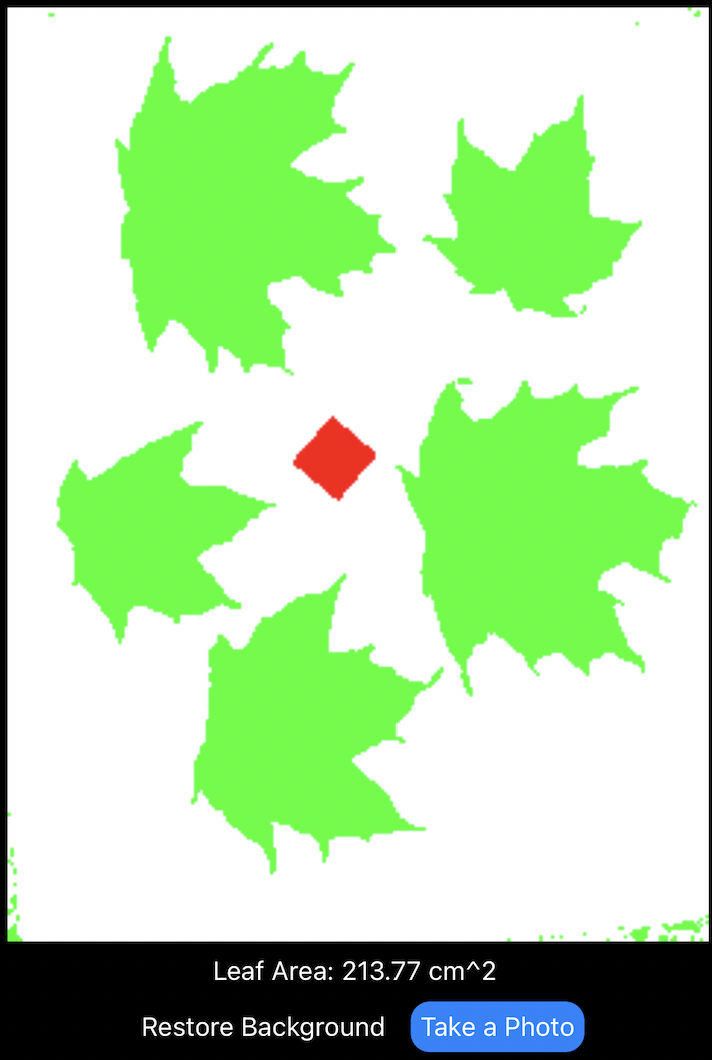

Aidan was all over the University of Minnesota Twin Cities campuses collecting foliar samples from a variety of urban tree species across an environmental gradient. He and mentor Jeannie Wilkening ventured out across the study sites at solar noon (around 1:30pm in Minnesota), when plants initiate maximal stomatal opening, and brought their samples back to the lab for analysis (pressure bombing!). Along the way, they witnessed an abundance of urban wildlife (squirrels, hawks, turkeys, oh my!). Aidan is excited to continue this iterative process and explore the data!


Catch ya next week!
– Frankie, Aidan, and the squad
Double Rainbow!!!
This week, we worked a lot with the professionals at Fond du Lac, learning even more about what resource management is like from the field work perspective.
For Wednesday and Thursday of this week we went electric fish shocking on 3 rivers located in different parts of the Fond du Lac reservation. The way it works is that one person holds a pack that is set up with a metal rod and net to shock the water at a low voltage that temporarily stuns the fish, so they are easy to pick up and transport into a collecting bucket. When we were finished collecting fish, we counted them off and recorded how many species we identified as we dropped each fish back into the river one by one. Our first day of stream shocking was on Wednesday. It was really rainy, but it was still very fun because of how much fish we were catching with this surveying technique. Then the next day on Thursday, we went to two streams to stream shock fish. We learned very quickly how easily you can tire out from handling so much equipment and being careful not to drop the bucket with all the fish in it as you are walking around and through slippery rocks! It was a great combination of hiking and fishing for this survey experience.
Some of the fish we caught were interesting as well. The most common types were daces and creek chubs, but we also ended up netting a small northern pike and an out-of-place burbot. The fishes we saw changed depending on which stream we were fishing in, and it was interesting to listen to our mentor Eric discuss how it has been changing due to climate change affecting the water temperature.






The farm at Fond du Lac was another experience team Zaaga’igan was fortunate to see and tour through. We saw about 4 acres of land on the farm that community members from and around the Fond du Lac reservation share to grow plants on their own plots of soil. Our guide Erika explained in so much depth about the way the plants are grown and who was growing what on their plot of soil as well. There was a dome shaped building on the farm land as well that held additional plants in an enclosed structure, used to continue growing plants throughout the long Minnesota frost season. A cannery was recently built nearby this farmland as well, so we were shown all the ins and outs of the building and the programs they run through with it. Later that same day, we also went to another smaller farm closer to the resource management building on the reservation. This is where we did some gardening, tending the plants, weeding, and meeting some of the people who work on this smaller farm. We were also shown a compost pile and explained a little bit about how it works regarding the process and its sustainability.



We also have been finalizing our work on our projects and putting everything together.
On Tuesday we met with our mentors Nate and Farhan to discuss our progress, and to critique our graphs and research outlines as well. From these meetings, our projects have continued to take shape.
Zach went further into the potential predictions made by his earlier graphs. After talking with Nate, he was shown some 2020 data of AVS and CRS, both of which have historically been used to predict the content of solid and amorphous phases or iron-sulfide in porewater. Using this, Zach will be comparing the AVS and CRS data with the 2020 graphs for pH, Fe, and HS/H, in order to see if the latter can be used to predict what phase of iron sulfide is present.
However he also hopes to get better clarity by getting XRD (X-Ray Diffraction) data from Spencer Bigham at the Twin Cities campus, a contact of Dr. Johnson who is studying a similar topic. The XRD data would show the exact minerals present in the different rice tanks, giving more concrete evidence on the utility of using thermodynamics for pore water chemistry predictions.
Tay has been working on his data plots for the wild rice biomass and seed germination. He’s been trying to make sure he understands the trends in data when sulfate loadings were on wild rice and then taken off to show a rate of recovery. It’s a little tricky because of how much data there is and how scattered it has gotten over the years. The main point though is to make sure the data is making sense with the year they were recorded and how they relate to other data that has been taken either years after or before.
This week we started collecting some data. Although many of the larvae died from bacterial infection, some butterflies survived and emerged from the first batch of diets that we made (Synthetic Rubber). For the ones that survived, we would keep them in a cage for one to two days to fully develop, then we place them into a freezer to sacrifice them. We would then pull off their wings and measure their wing span using ImageJ. We then took the females, dissected them, and did an egg count.
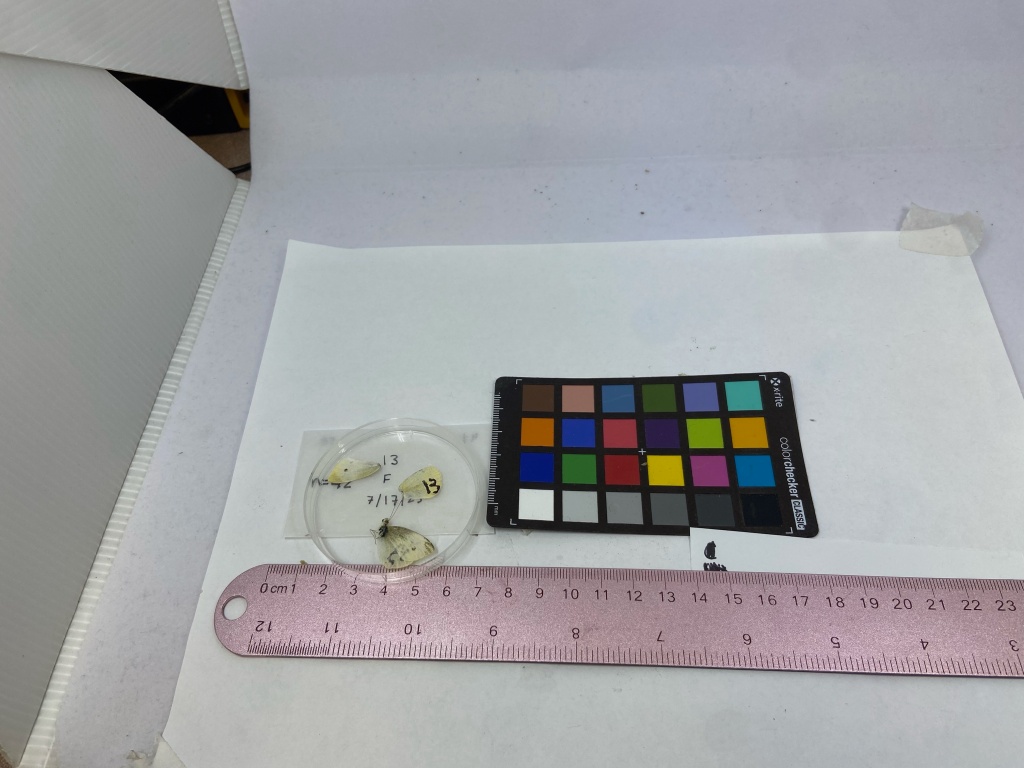

The lab was very excited to have a film crew come in and video the whole process of the experiment this week. We had a lot of fun doing it, and we are now considering a career in acting! We also made a new batch of diet, using new antibiotics. Other than that, we have been repeating the same process of collecting eggs and transferring them to new diets.
Hello again! Now over halfway done with the program, the Urban Nature Group is back with more updates!
Frankie spent some time in the lab this week working with the foliar samples her team collected from their four parks across St. Paul. She experimented with a new foliar washing procedure in efforts to quantify the dry deposition of heavy metals on the surface of the leaves. To prepare the samples, Frankie had to calculate the total leaf surface area of each collection and wash each sample for 30 minutes with a 1% HNO3 solution. She plans to use this data in her research project this summer and take a closer look at how the dry deposition of metals varies across these urban spaces.
Aidan spent the first half of the week inventorying trees across several University of Minnesota campus study sites. This involved verifying the locations and conditions of the trees, as well as making some standard forestry measurements. This enables him to start measuring water potentials next week! In the latter half of the week, Aidan traveled to Berkeley, California and paid attention to the unique urban tree phenologies that allowed the vegetation to thrive.
See you next week!
– Frankie and Aidan
This week was a little wacky, a little weird and most definitely whimsical
Monday and Tuesday we had some quality time working on our lit review and annotated bibliography. Wednesday we had our final field day at the cemetery for GPR Team 😥 After a really productive day of wrapping up data collection, we made a stop at the Ninepipes Museum of Early Montana & gift shop for a bit of exploration time and a coffee pick-me-up.
Thursday, some of us took a trip to Missoula to accompany Tony on his errands. We tried an amazing ramen place (Michi Ramen) and highly recommend it if you’re ever in Missoula!
To end the week off, we had an office day and the wetlands team took out our “crayons” and drew some designs up for East Bay, leading to some really great creative discussions.

Finally, we leave you with a snippet of an email from our wetlands East Bay mentor Mark Lorang:
This week saw us working mostly in the lab, along with a few meetings to catch up with each of our mentors so that they could give us further information for our projects. However, the highlight was certainly on Tuesday, as we were excited to get our second field experience out at the Fond du Lac reservation.
To start things off, Monday was another session with Diana online zoom where we learned more about what everyone was doing while also ironing out our explanations for our research projects. The next part of our zoom session ended with Cody teaching us how to use our maps on ArcGIS and the survey123 website. We both were pretty drained after that but were looking forward to the next day when we would be able to go out to the Fond du Lac reservation.
On Tuesday, Team Zaaga’igan were ever so fortunate to shadow the day out on the reservation with one of the invasive species specialists Phil. He was a very nice person who taught us both so much about the history, the importance of the wild rice, ethics in research in relation to the tribe, and also what invasive species were in the area. He showed us how to tell the difference between native snails and an invasive snail called the Chinese Mystery Snail (CMS), which you could mainly tell from the trap door mechanism in its shell. We learned this as we waddled around the edges of lakes in the reservation in trousers/overalls that were waterproofed for us.


We also got to work with plants that day and identified a few types that are known to be issues in the reservation: tansy, black locust, buckthorn, and wild parsnip. We were able to learn how to get rid of black locust in a resident’s backyard by using a method called hack and fray where a part of the plant’s branches are sawed off the side until the cadmium is reached, and then a low dosed solution of herbicide is applied on the area. This is meant to specifically target the black locust and none of the other plants around it. Hence, it is also a reason for using a low dosage of the herbicide in the process.

The opportunity to work with Phil was great as well because he was native and from the reservation, so any questions we had to ask or were unsure about relation to traditions, wild rice, or anything to do with his job he very patiently and amiably answered. The entire day was very well spent talking with him as he took us around the reservation to shadow him.
At the end of the day, we were invited by a worker at the Fond du Lac Reservation to play lacrosse at UMD’s football field, which is pretty close to where we are living. We of course went and there was a bit of a learning curve for handling the lacrosse sticks and picking up the ball, but playing with the people and kids from the area was what made it a fun experience. Everyone playing was very friendly and happy to teach us tricks with picking up the ball and teaching us how to play. Lacrosse that evening wore us both out due to how much running up and down the field we did that day; it certainly helped us get ready for rest for our next days which we spent in the school building working on our research projects.


Wednesday we went to the lab to talk with our faculty mentor, Nate, about the next steps of our projects. He helped Tay figure out more of the type of data he should be focusing on and he should be thinking about it when it comes to his research question.
Thursday we met with Anna Peterson, one of our mentors at the Johnson lab. We went out to the UMD farm again to check on the biological status of the wild rice and to see the specifics of the methods used to do so. We also talked more about the history of the UMD farm and the lands it and the university are located on.
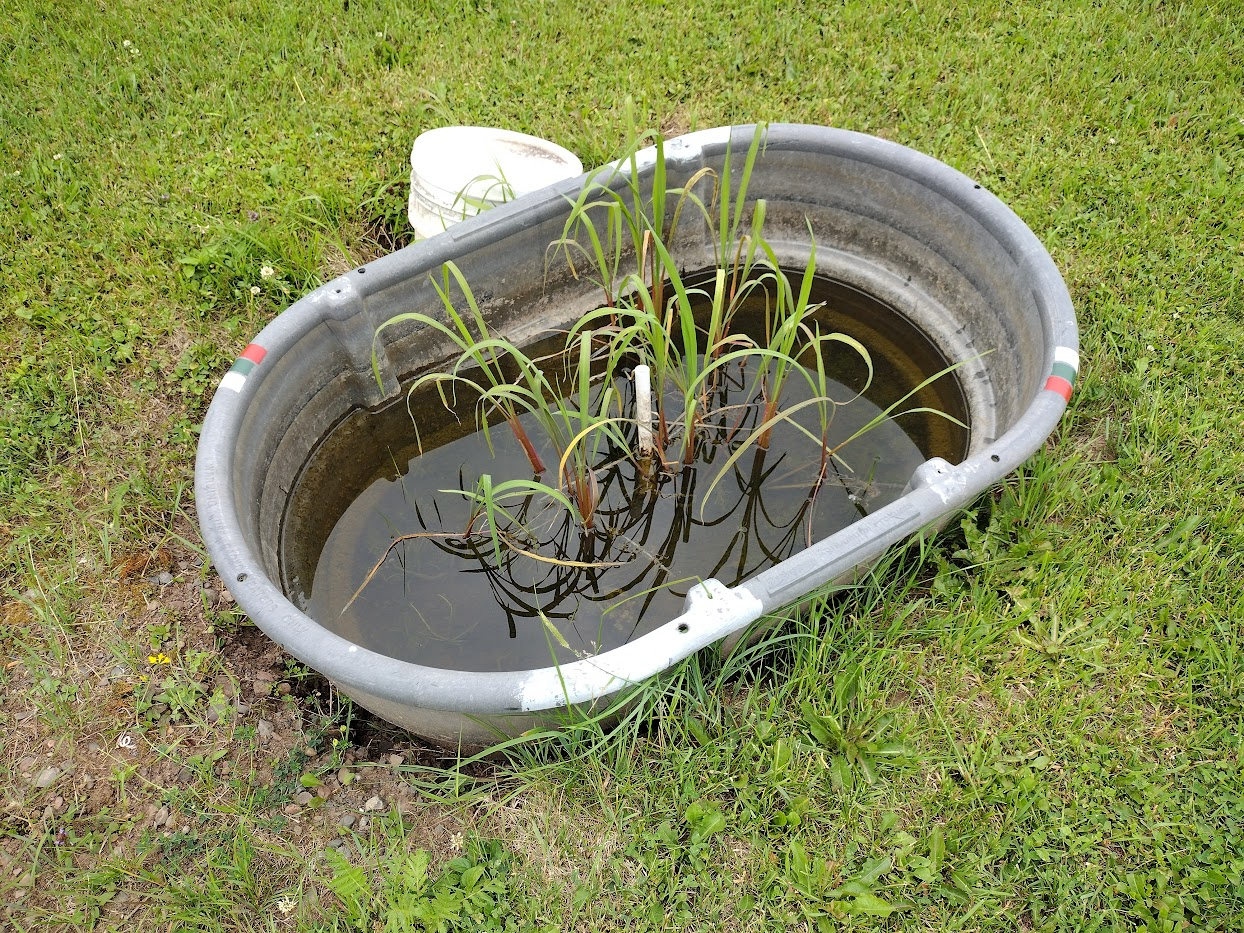

Friday we met with our remaining mentor, Farhan, who talked to us more about better graphing practices in Excel and the importance of making graphs easy to understand for your audience.
As for our projects themselves, here are a couple of short updates:
After finishing up with the 2023 data, Zach worked on aggregating and graphing the data from 2015 and 2018 as well in order to compare the pore water of the almost fully recovered tanks from now with what was happening when tanks hadn’t yet started recovery at all and when they had only been in recovery for a few years.

Once Tay got a better overview on what parts of biological data he should be looking at he made many graphs plotting germination and biomass differences in 100 ppm treatments ranging from the years 2011 to 2023. Tay also read up more on the biology and historical importance of wild rice for the Ojibwe.

Next week will see us spend even more time at Fond du Lac, and we can’t wait to talk about it.
Until next time!
-Team Zaaga’igan
“This week I have been focusing on sediment composition analysis for 2 of the 4 lakes I am studying and I finally got results! This meant A LOT of looking in the microscope, second guessing my estimations, and ultimately settling for suitable percentages. Graphing all the composition aspects together with all the different error bars as well as time periods turned out to be a challenge but ultimately I made some figures and wrote parts of the results and discussion sections of my paper.” – Saheli
“This week, my mentor and I finished cleaning and sorting through the germinated seeds that were incubating in the petri dishes. You can see a photo of the cleaned and sorted un-germinated seeds in a pretty circular pattern below. We experienced a slow germination rate with the seeds this week, we hope next week things will pop off.
Additionally, we worked on tetrazolium staining the Manoomin seeds to assess their viability. We took 100 and 50-count seed sample sizes of different environmental conditions, wet or dry, of the 2 water bodies we’re working with, Haycreek and Deadfish Lake. We made incisions in the seeds to allow the tetrazolium solution to soak into the seed for about 24 hours. After soaking, we are able to see which seeds are “viable” or “dead” based on if they turn pink to show they are respirating. The dissecting microscope photo below shows the variability of Natural manoomin seeds (green/brown, long/short, skinny/thick). There is one particular brown seed that has a jagged shape. This comes from outgrowing the hull (protective seed coat) while it is still encased, as a result the seed is forcibly squished.
The last project my mentor and I worked on was using ArcGIS to develop GPS grid coordinates and maps of the water bodies we will be doing fieldwork at in Lac du Flambeau next week. We created 2 maps using a systematic grid plot and a randomized sampling point plot as 2 different ways to gather our Manoomin vegetative survey data.” – Amalia
Other parts of our Team Manoomin’s week consisted of a Manoomin Collaboration All-Hands Meeting on Monday with all of our collaborators, a Manoomin Collaboration All-UMN Meeting on Tuesday about ongoing research, a Natural Resources St. Paul Campus tour directed by Dan Larkin on Tuesday, and safety training and trailer driving workshop with Naomi on Thursday.
This week was a pretty slow week as we are waiting for the new antibiotic to come in so we can make new batches of diets. We spent most of our time hunting for more cabbage whites, collecting eggs, transferring larvae onto the new diets, practicing directions, throwing out the bad batch, and having fun in the lab.



Week 2-3
The past few weeks have been very hectic. For the first two weeks, we spent most of our time in the field collecting different kinds of butterflies. We would walk around different parks with our bags that had ice and envelopes, as well as our nets. We would place the butterflies into the envelopes and on top of the ice to cool them down, which slows down their bodies. After spending the day in the field, we would take the butterflies we collected back to the lab and try to identify some of them.
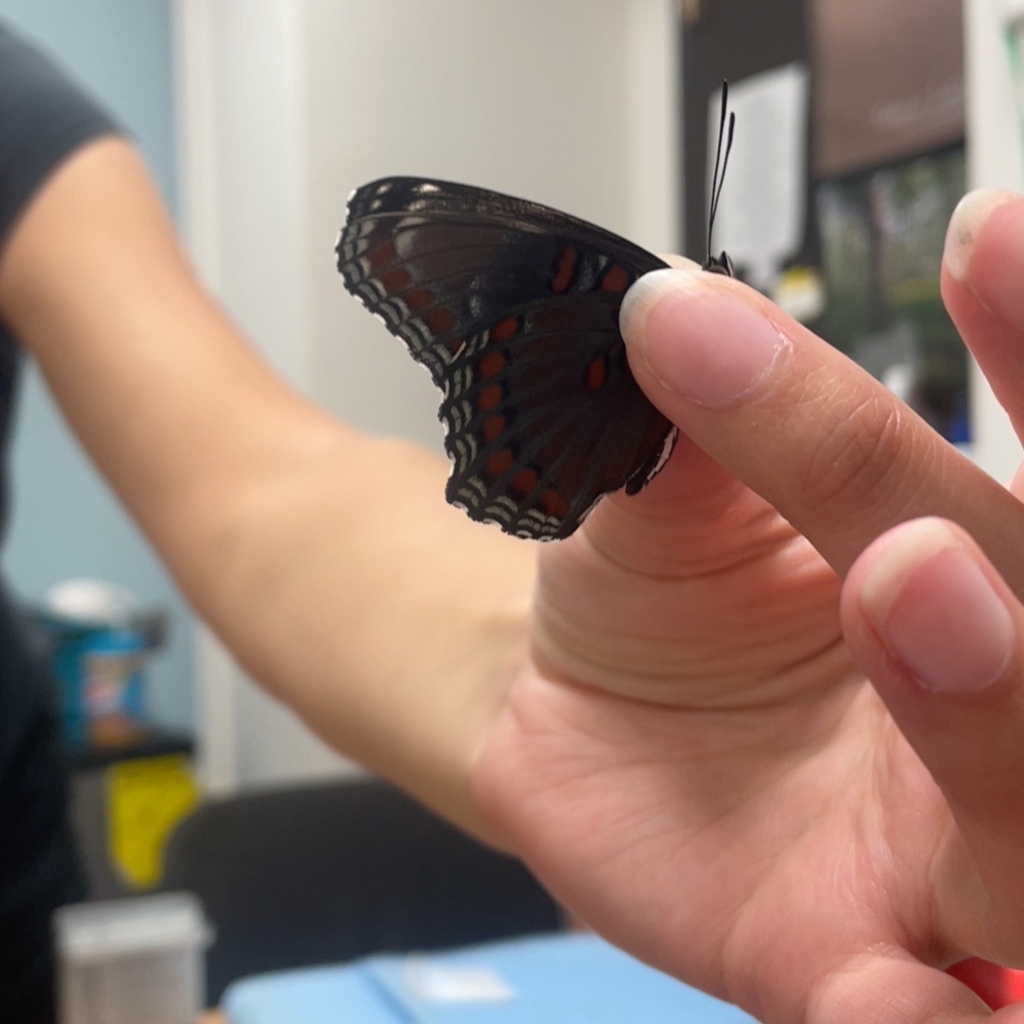
We also started our experiment by making a few batches of diets. They consisted of control, 0.5%, 1%, 2%, 4%, and 8% of synthetic rubber. We also went out and collected cabbage whites, specifically females, and then placed them into cages to collect their eggs. We collected the eggs and placed them in an incubator.
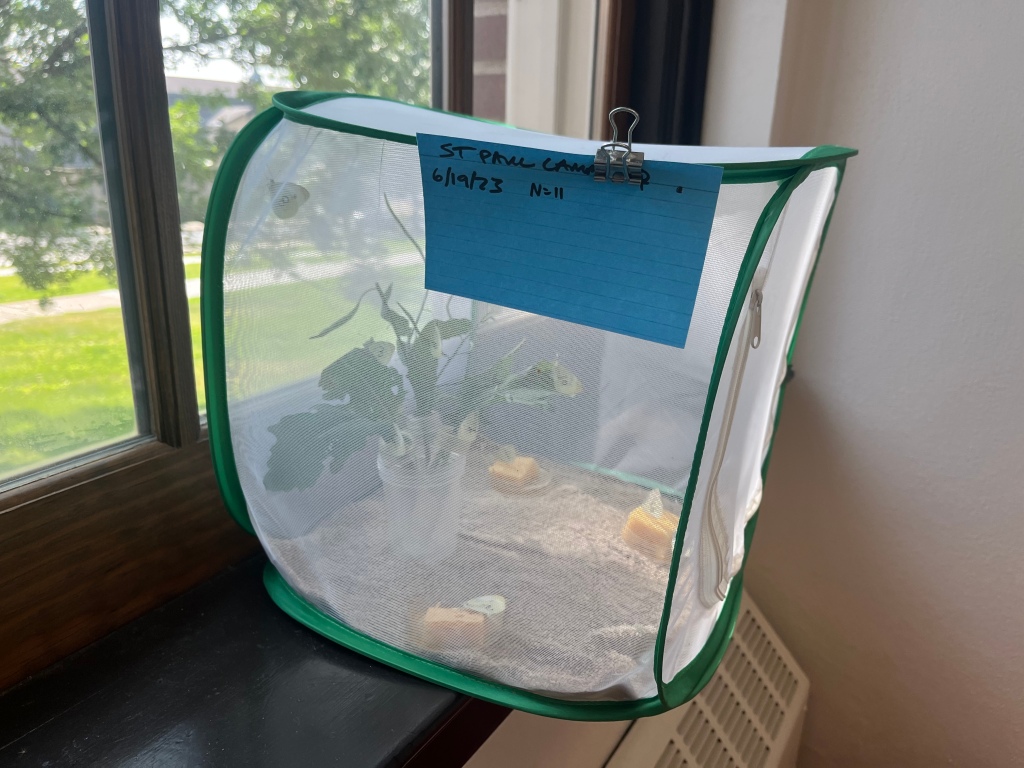
Week 4
After a week of having the eggs in an incubator, we transferred the larvae (caterpillars) to the artificial diets. We would place 3 larvae per container and number each of them, making sure to poke holes into the container to give them air to breathe. We then placed the containers in the incubator and observed them throughout the week. We also spent some of our time making a second batch of diets and used PE (a major ingredient of tires) instead of synthetic rubber.

We also came across a problem this week. When checking on the larvae that were transferred the previous week, we found a film of bacteria. We are unsure why this has happened, so we are now trying to troubleshoot and start fresh with the PE diets. To take extra precautions, we are disinfecting and bleaching everything after each use and making sure everything is as clean as possible.
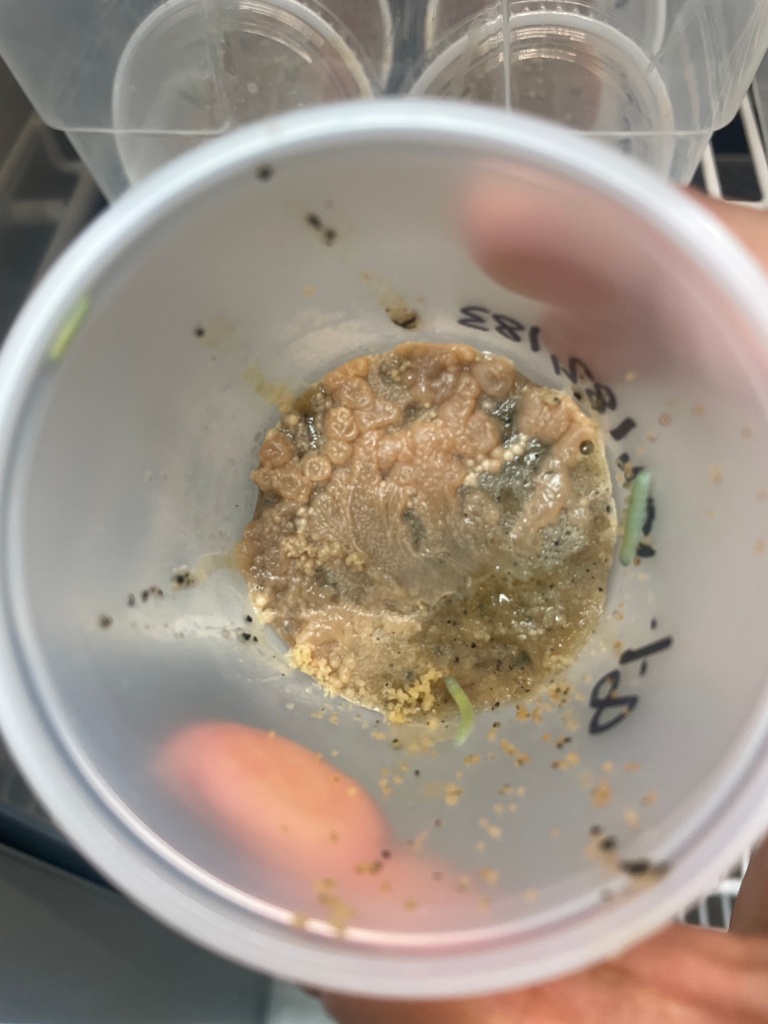
“This week was short so I have been doing readings and working on smear slide composition analysis, which means looking in a microscope and making estimates of percentage composition within the sediment of mineral grains (quartz and feldspar), calcite, diatoms, sponge spicules, cysts, amorphous algal organic matter, charcoal, and pollen/spores/plant bodies. It’s fun but also daunting because it’s pretty hard to make accurate estimates. To account for this high error, I look at all the slides from a core in one sitting/day, referencing back to previous slides often. This makes the estimations more relative/comparative along the core so, even if the actual percentages may be quite off, the comparison along the core will be more accurate. Pictured is a smear slide sample of the Gunlock Lake core interval 46-47 cm at 40 times magnification displaying amorphous algal material and some massive (and mini) diatoms.”
– Saheli
“This week my mentor and I finished prepping the test tubes with a Hoagland Solution, then transferred the Manoomin seeds into the solution. The seeds were previously held in 4 degree celcius growth chambers and immersed in lake water for 8 months to simulate a typical, intense winter period. Being immersed in water for 8 months is one of the conditions needed for Manoomin seeds to ‘stratify’, which prepares them to germinate. Although an important observation this week was that many seeds (~50) had germinated while being held in their lightless, ‘dormant’ stage,
After transferring the seeds into the test tubes, we put them in a new growth chamber with a humid, warmer climate. We will begin monitoring the seeds, taking note of which ones germinate. After 2 weeks, we can begin measuring their growth in height, weight, root length, etc.
There is also another part to the experiment using dry and wet seeds in petri dishes. This is to provide proportional data on how the seeds react to being incubated in wet vs dry conditions. This might simulate the varying water levels that could leave the seeds exposed at some point in time, potentially impacting their stratification conditions. To move forward this part of the experiment, my mentor and I changed out the lake water for the hydroponic solution and wet all the dry dishes with 45 ml of solution.
– Amalia
Other parts of our Team Manoomin’s week consisted of ongoing biophysical research presentations from our mentors, Sirena and Hima, and our intern coordinator, Gigi. Also, the REU intern/Manoomin collaborative picnic and a hydrogeology field methods training run by Gigi.
The Urban Nature Group is staying busy around the Twin Cities!
During their field day, the team found that a couple of their tree monitoring sites had been fully trashed and ripped apart. Thankfully, all was not lost, and the team was able to clean up the sites and reestablish both the sap flux sensors and throughfall collectors. This was a good learning experience as it gave us a better understanding of what doing research in highly populated urban areas can look like.
Frankie got to spend some more time in the lab this week processing the throughfall samples collected in the field. She got to work with the UV-visible spectrophotometer to analyze the total soluble reactive phosphorus concentration of each sample. She has also been going through a lot of literature in efforts to learn more about the best procedures for quantifying the dry deposition of heavy metals onto the surface of leaves. In the coming weeks, she hopes to perform a similar experiment using the ash leaves from the trees the current LTER projects are monitoring.
Aidan wrapped up his processing of hundreds (821 to be exact!) of fisheye photos of tree canopies around the city in order to determine the leaf area indices (LAI) of several different ash and maple trees. He analyzed the LAI outputs in RStudio and compiled several time series to illustrate the growth rates of tree canopies across species and space (see one park’s trees’ preliminary results below). Outside of LAI analyses, he is beginning to plan his field excursions to collect leaf samples from different areas, different physical environments, and different tree species all over the University of Minnesota campuses in order to measure their water potentials and assess variations in stress that urban trees experience.
Check back next week for more thrilling updates!
– Urban Nature Group
The first few days of this week we were off for the 4th of July, but we tried to make the most out of the free time we had. On Sunday, we made our way over to Wade stadium to watch the local Duluth Huskies play against the Bismarck Larks. The teams are in the Northwoods league, which is composed of college players. For lack of a kinder word, the Huskies pummeled Bismarck 13-2, scoring 9 in the first inning alone. It was a fun game to watch!
As for Monday, we visited a nearby park called Enger Park known for its large tower peering over Duluth and Lake Superior. We first spent some time on the trails at this park; afterwards, we took the stairs up the park’s Enger Tower for a bird’s eye view of everything surrounding us. Later we restocked on our week’s food supply. On the next day, we went on a fourth of July outing downtown Duluth. We spent our day walking around and seeing what the city of Duluth was doing to celebrate. We were waiting for the fireworks to set off later that evening at 10PM for Duluth’s fourth of July celebration. We eventually found a good spot at Duluth’s Rose Garden, offering us a good view of the fireworks being launched above the Duluth Aerial Lift Bridge.

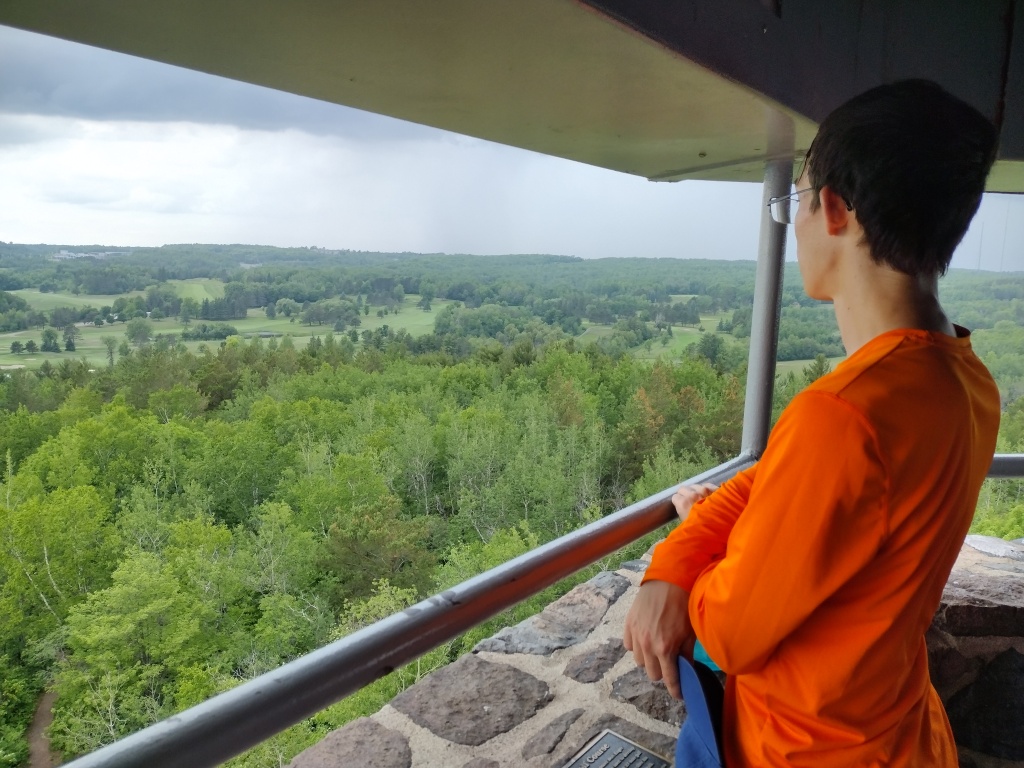

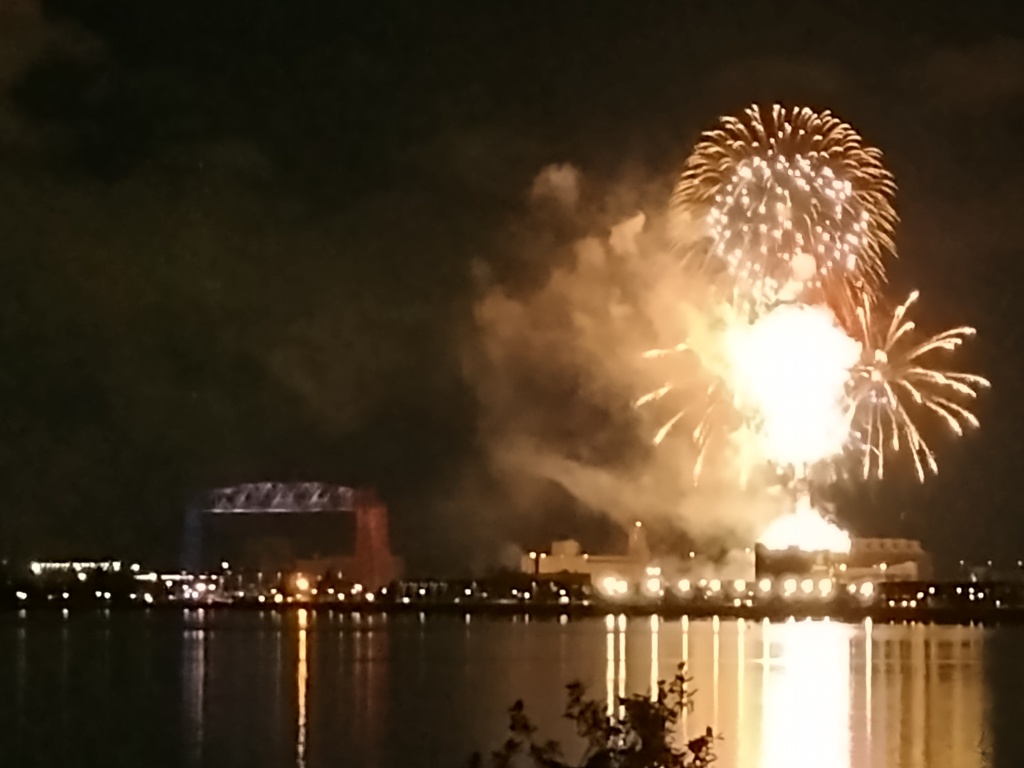
After the Holiday weekend, it was back to our projects. We continued sifting through our spreadsheets in excel, expanding to data from past years as well. During this time we also made further developments on the specific focuses of our studies, as we have narrowed our interests to a few key questions.
Along the way, we were also helped by our mentors Nate and Farhan, who taught us some Excel tricks and more about our respective projects.
For the next few days we spent a long time playing with the data we had available towards us. We were making outlines of plans for our research question and the way we wanted to present our data to answer that research question. As we brainstorm ideas and work on excel in turmoil, we are gaining a better understanding on what our research project is so we can articulate it for others to understand.
This 2-D line graph is a simplified version meant to practice demonstrating how treatments of sulfate in the water force a declined amount of wild rice germination for different levels of treatment. The recovery time for the wild rice should return after a certain amount of time. We are trying to figure out if that amount of time to recover depends on the dosage amount at the moment. The graph is just a small prototype and only one of the many pieces of the story from this research project.
This shows the relationship between sulfate treatments (loaded means sulfate is still being added, and recovery means sulfate is not being added), sulfide concentration, iron(II) concentration, and a theoretical solubility product line, using our data from the 2023 peepers. It seems that the longer recovery, the less sulfide there is, and the lower the sulfide, the higher the iron(II).
On Friday, after finishing another slow day working through excel on data for our projects, we were given the opportunity to go to a powwow. This pow wow was the first one for both of us, and we were happy for the opportunity to visit. This powwow was in commemoration of the veterans involved with all of the wars the US have been involved with, and the powwow started with honoring the veterans with flags. Next, the dancing and music from the vocals and drumming were performed throughout the rest of the event. The clothing worn was beautiful because of the craftsmanship, colors, and unique creativity belonging in each of the clothing designs. We learned about some of the basics of what goes on at a powwow, but we are definitely looking towards asking additional questions about the culture when we spend some more time at the Fond du Lac reservation.
We finished the week with an excursion to the towns of Hibbing, Chisholm, and Ely. In Hibbing we got the chance to see one of the iron mines that may play a role in leeching sulfate into the watershed. In Chisholm we visited the Minnesota Discovery Center, where we learned more about the history and culture of the iron mining region. And in Ely, we simply explored the city and the surrounding nature, including Kawishiwi Falls.
View from the old iron mine pit in Chisholm, Mn
View of the Kawishiwi Falls
This week started off with a bang at the Arlee Powwow: the longest running powwow in the country. We spent our Saturday partnering with the University of Montana at the powwow with a water table educating children about river systems and getting involved with the community. This was an amazing experience and gave us the chance to enrich our knowledge of the deep cultural roots of the tribes here. On our way back to the dorms we stopped by the Garden of 1000 Buddhas to walk around and spend some time meditating.
We also had a great couple of field days this week. Monday, we were back at the cemetery collecting GPR data on an area of suspected burials. Once collected, we spent some time on data interpretation and troubleshooting with processing the slices of scans in the area.
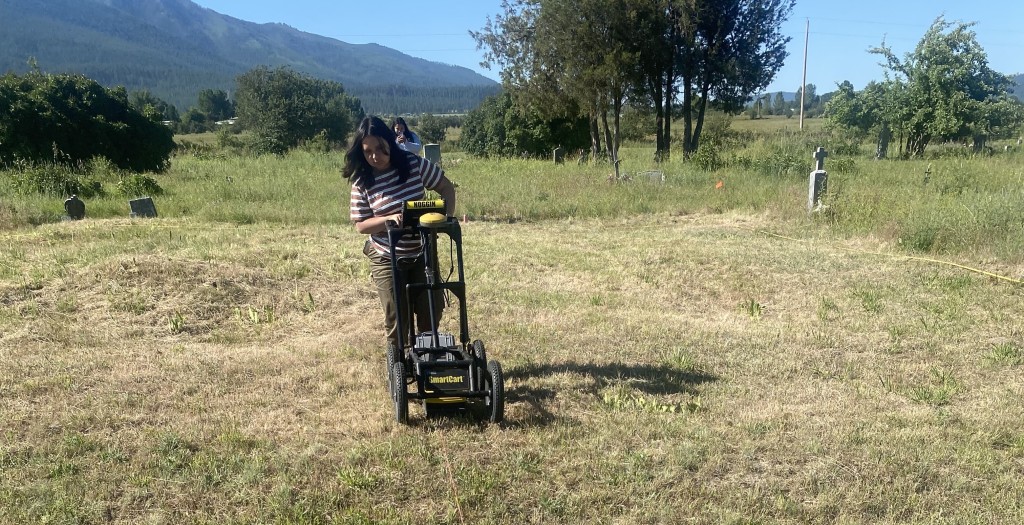
For the fourth of July we spent some quality team bonding time on Flathead Lake. We ran into some technical issues with the pontoon, but all is well now, and the boat is fixed!
Wednesday, we began the day with a conversation with Mark Lorang and his epiphany about how we can model wave energy in East Bay of Flathead Lake. We can then use this model in conjunction with erosion prevention methods to qualitatively determine the most useful method for this bay. Then we listened to a talk from Barry Hansen, our wasteway mentor, on the history and purpose of developing the wetlands. It was incredibly informative and interesting to learn about it from the man who designed the project. After our creative problem-solving session, we hit the field to go collect some soil samples in the wasteway project. The wetlands water supply was diverted last week so they would have an opportunity to dry out before our sampling period. Once out in the field, we were surprised at the variation of saturation between the different wetland cells and the difficulty in collecting surface and organic samples. We were able to at least get a sample at depth at each of our desired sites and sent it off for analysis.
Thursday and Friday we spent some time at the office working on our methods section and had another discussion with Mark Lorang about the potential for our project to offer valuable insights for future management of the East Bay shoreline.
Team SPAW would also like to comment on the beautiful community we’ve shared and seen within our research and community partners. We are in “rare air” as Georgia Smies, one of our SKC colleagues, once said with reverence for her coworker Mark Lorang.
– Marco and Clay
This week for Marco and I have been punctuated in understanding the complexities of how to incorporate various functions into our codes. We utilized our Jupyter notebook to practice our Python code, as that has been a great resource for understanding code. The homework Marco and I have for the 4th of July weekend is to understand how to import, debug, plot, and add functions to our code. Coding will overall help us with modeling our Digital Elevation Models in Python and incorporate other open-source software like Blender to help start our projects. Blender is software that can help with modeling animated films, 3-D models, motion effects, games, etc. The tasks we have for coding will be instrumental in showcasing the work we have in modeling river networks for our projects.
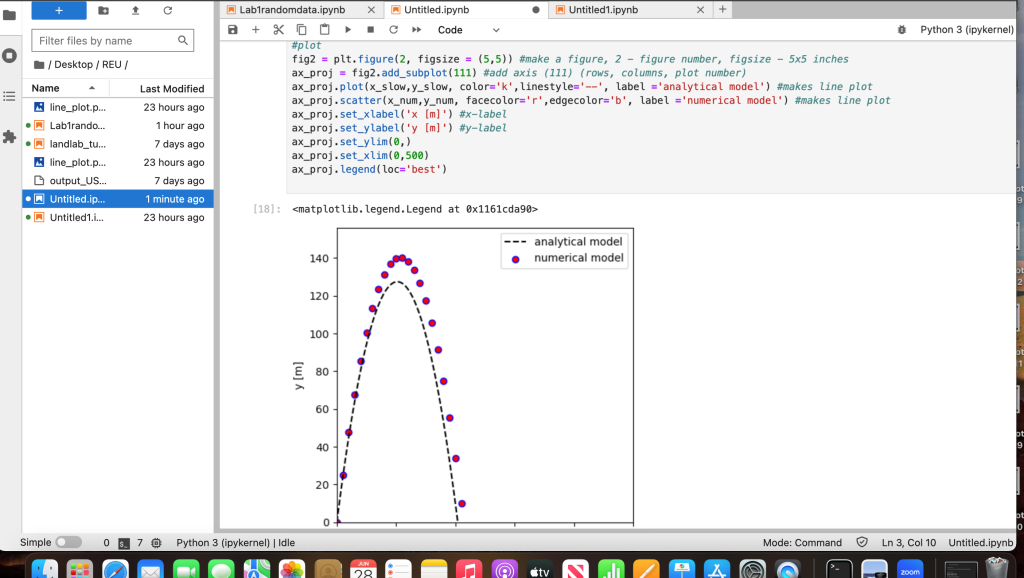
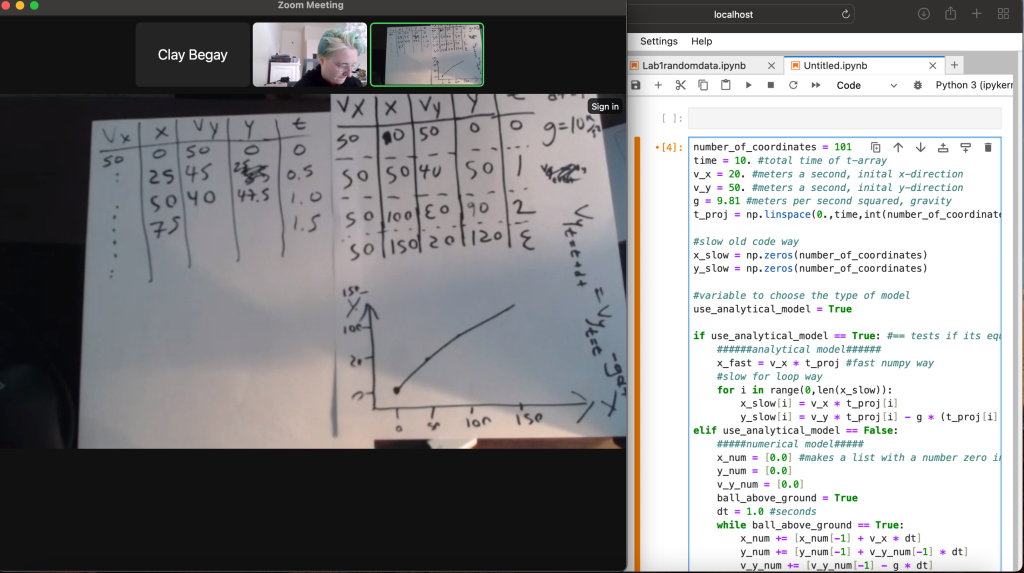
– Travis
To start the week, we had a SLAWR team meeting to learn about everyone’s research projects and learn about ArcOnline with Cody. On Tuesday I met with Judy Yang and the research team to discuss the direction of my research.
I was able to gain a basic understanding of my research topic by conducting preliminary “tube experiments” in which we created a solution of synthetic, translucent clay called laponite and water, and three other solutions of water under varying salinity.
I familiarized myself with MATLAB coding techniques by studying old source line code from previous experiments. Using Survey 123, I created a survey to learn more about the research interests and specialties of my research team. I also learned more about the history of the Twin Cities, SAFL, and the homelands of my research team.
At the end of the week, I used a shaker incubator to mix the clay-water solution with saltwater. A total of four test tubes were filled, each labeled based on pure, low, middle, and high salinity.

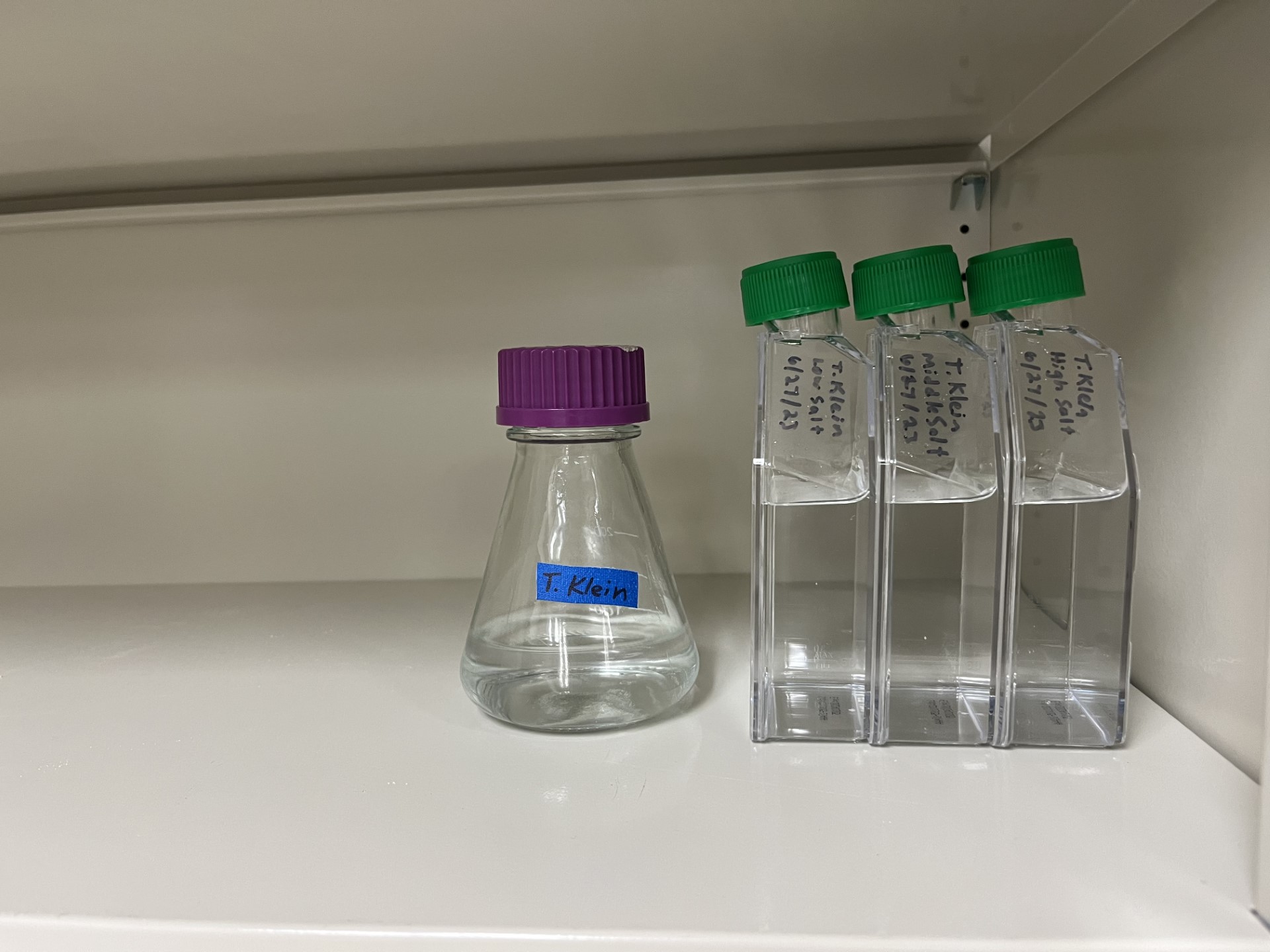

Friday was a busy day. A group of high school girls toured SAFL and learned about the laboratory from each member of Judy’s research team. I photographed the tour and the water diffusion science experiment presented by Dr. Yang. After a successful tour, we celebrated with Nico’s tacos for lunch. Lastly, my graduate mentor, William, taught me how to use imaging technology, such as Spinnaker SDK and confocal microscopy, to visualize the results of the tube experiment, which led to deeper insights on clay-brine interactions.

“I have been doing TONS of reading to understand lacustrine (lake) sediments and their clastic (minerals – allochthonous), chemical (minerals, often precipitated – autochthonous), and biogenic (fossil remains) components and what changes in each could indicate about the history of a lake. I have also been reading up on my research sites/lakes and their watersheds, habitats, and history. Lastly, I have been making smear slides for the sediment cores from my research sites. Smear slides are a thin layer of unconsolidated sediment on a glass microscope slide. Below is a photo of some things I have seen (mostly diatoms and amorphous algal matter). 63x is the magnification, GLOCK stands for Gunlock Lake, and 24-25 (cm) is the sediment interval of the core that I sampled for this particular smear slide.” -Saheli
“This week in the lab, my graduate mentor and I worked on preparing test tubes in well plates for our seed germination experiment next week. After cleaning and labeling over 1000 test tubes, our next step is pipetting the hydroponic solution that the manoomin seeds will grow in for a 2 week period. I will update on how the germination and measurements of their growth rates progress in the coming weeks!
On a fun note, I also enjoyed getting to know my mentor over lunch and homemade ice cream from the U of M – St. Paul Campus’s dairy cattle.” -Amalia
Other parts of our Team Manoomin’s week consisted of a cross-disciplinary networking student workshop with another REU team in the Twin Cities (RAMP), a tour of the Continental Scientific Drilling (CSD) Facility Core Laboratory, and a meeting where we were introduced to others from the UMN team of the Wild Rice Collaborative.
To begin, we all started this week with our first online zoom session with the other teams. It was interesting to learn about what the other groups were doing within their research labs for the first week. When our session with Diana was over, our other coordinator Cody helped guide us through a website called ArcGIS Online we have to get familiar with because we will be using it to create our own story maps for this summer. It was a slow process, but it was very necessary so that we could make sure everyone was on the same page.
After the ending of our zoom session at 12PM, Team Zaaga’igan ate their lunch and went on a short hike nearby where they are staying. The hike helped clear our heads from a morning full of insightful presentations and learning. We decided to check out a trail that was only about a 5 minute walk away to get up a large hill caled Rock Hill Overlook. We noticed how steep the trail got as we started getting closer to the Overlook, but once we made it up to the point, we could see downtown Duluth, Minnesota and its skyline- along with Lake Superior as well.
On Tuesday we drove over to the Fond du Lac Reservation after getting our rental car for the week to use. As we drove down to the reservation, the air looked very hazy and difficult to see through. Later, after meeting and getting introduced to Nancy Schuldt, the water projects coordinator of the Fond du Lac Band of Lake Superior Chippewa, we realized our suspicions about the air quality looking rather off were confirmed. We were shown through the computer of an air quality scientist at the reservation how much smoke was moving into the Minnesota area, which was likely from the wildfires occurring in Canada.
This ended up being just one part of a tour of the reservation’s resource management division office, where we met many of their staff members. We also got a brief summary of some of the tribe’s history and their views of the issues we will be assisting with during our time here. We then got a driving tour of the reservation itself, which included a brief experience of testing lake water for E. Coli and a quick drive-through of Jay Cooke State Park.


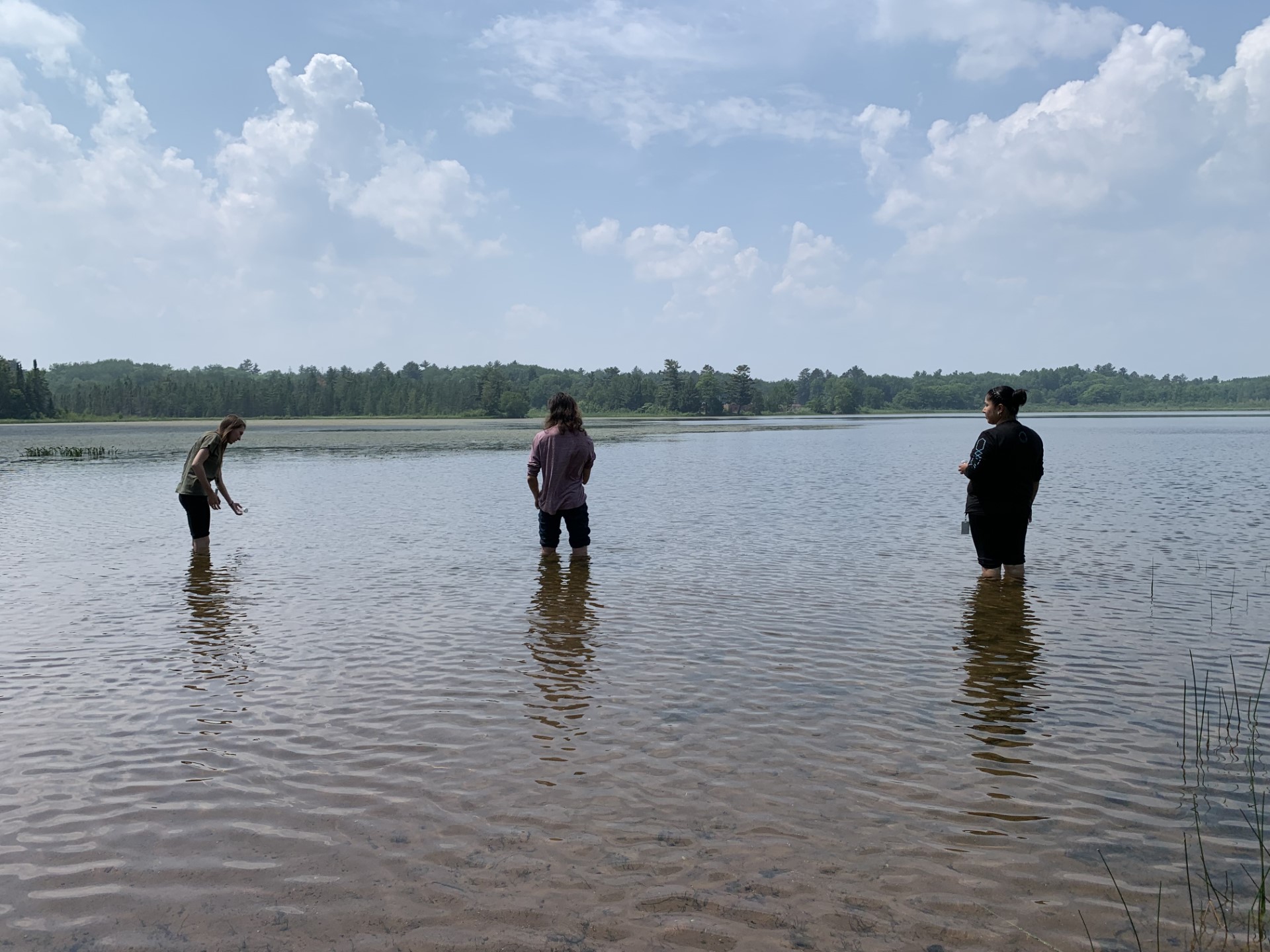
After that, it was back to the Johnson lab at UMD, where we finished logging the data we collected from the mesocosms in week 1. There were a lot of entries to go through, but we managed to sort through it all and make it work. That said, we also learned that formatting and consistency matters quite a bit in these situations.
On Thursday we continued this, and began brainstorming ways to use the data for the creation of a research question. This came from a few discussions with Nate and a little bit of tinkering with pivot tables in an attempt to find meaningful patterns within the data.
On Friday we had a meeting with our mentors Nate and Farhan to discuss our research questions, plan out our next steps, and get a little more practice with graphing and making pivot tables.
The framework of our experience has now been set, and we now get to go into the meat and potatoes of our research. Along with that, we’ll also be looking forward to the future resource management experiences we’ll be getting from those at the FDL reservation.
Thanks for reading, and see you next week!
-Team Zaaga’igan
Team Stream – Urban Nature Group has had a busy third week full of both lab and field work! The team kicked things off by performing routine maintenance on their sap flux sensors, throughfall collectors, soil moisture sensors, and temperature gauges situated at four parks throughout St. Paul.


Frankie spent most of her week in the lab with mentor Lucy Rose working on organizing the throughfall samples collected from the sites (thank you rain!!). They measured and labeled a whole lot of samples to be sent off to a different lab to quantify the nitrogen and carbon concentrations. Thankfully, Frankie and Lucy were able to quantify the concentration of soluble reactive phosphorus in all samples using the spectrophotometer in the local St. Paul lab.


Aidan spent much of his week processing digital hemispherical images (fisheye photos!) of tree canopies in order to determine their leaf area indices— dimensionless measures for the total area of leaves per unit ground area. He is continuing to process a year’s worth of photos so as to characterize the growth rates of trees around the city. Stepping away from the computer, he was also able to learn from mentor Xue Feng how to use a pressure chamber (or pressure bomb) in order to calculate leaf water potential.
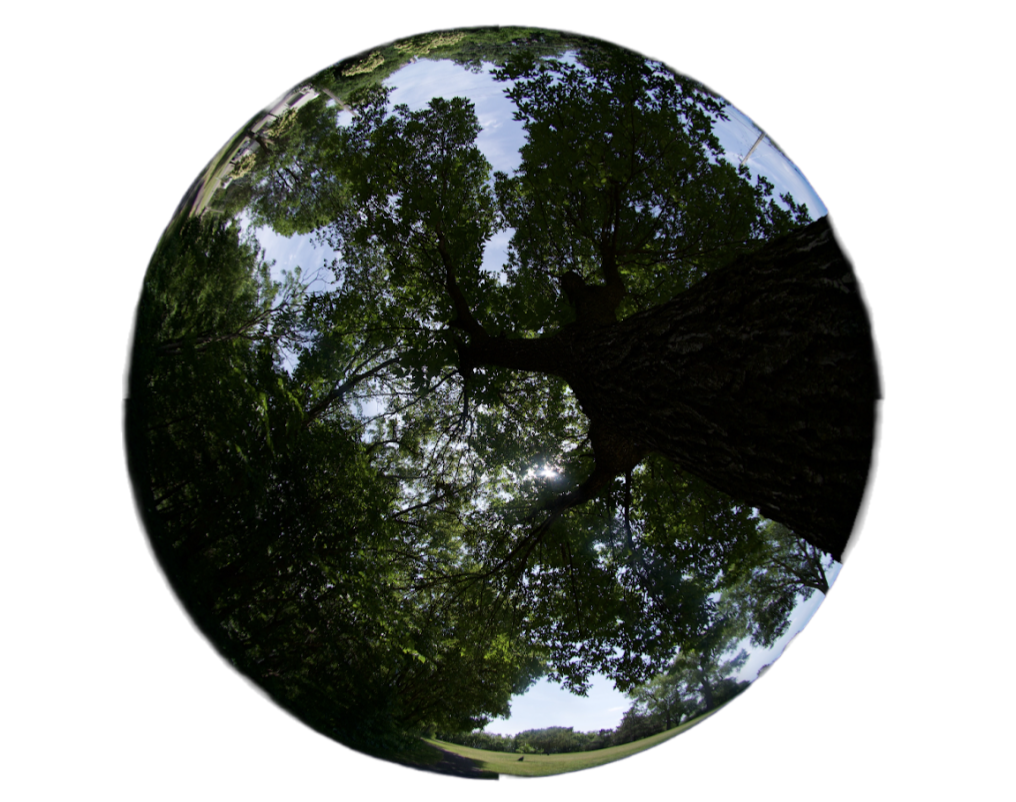

The team ended the week helping teach a photosynthesis-based educational game to a group of summer campers at the Bell Museum! It was a very intense game and these kids were stoked to learn about how trees use sugar and water to keep them alive and prosperous.


We’re back at it again this week with some exciting field work and project development! Monday, we spent some quality time learning about the other team’s projects and learning more about Arc Online. After our group call, we spent some time with Cody troubleshooting our GPR resolution in ArcGIS. Tuesday, we were back at the cemetery doing more GPR scanning. We are making great progress on covering the area and are about ⅓ of the way through the contracted area.
Wednesday, we had our first field day in the wetlands with Barry Hansen! We spent the morning taking some samples of the plant life and water in various pods. We also got the privilege of meeting Huck, the cutest field work dog!
We made our way up to Kalispell that afternoon to drop off the samples, where we met Dennis Brosten.
Through our conversation with Dennis, we gathered a lot of useful information about plant and wetland management. On our way back we stopped at Somers Beach, a beach manufactured by Mark Lorang to prevent shoreline erosion. It was super gratifying to see the results of a project similar to the one we are modeling on the East Bay project be so successful!
Thursday, we met with Virgil in the morning to get involved with the Arlee powwow this weekend and got a tour of the greenhouse on campus.
That afternoon we met with Mark Lorang to discuss the East Bay project and outline some modeling ideas and data needs. Friday, we relaxed a little from our field heavy week with some data processing and work in the office. We’re looking forward to the Arlee Powwow this weekend and some time off for the Fourth of July!
After an exciting time in Glacier and Minneapolis, we finally made it to our summer home. After a day to settle in, we spent our Juneteenth exploring the city of Duluth. We saw Lake Superior, lighthouses, a museum dedicated to the city’s maritime history, and even got to see a boat pass under the famous lift bridge.

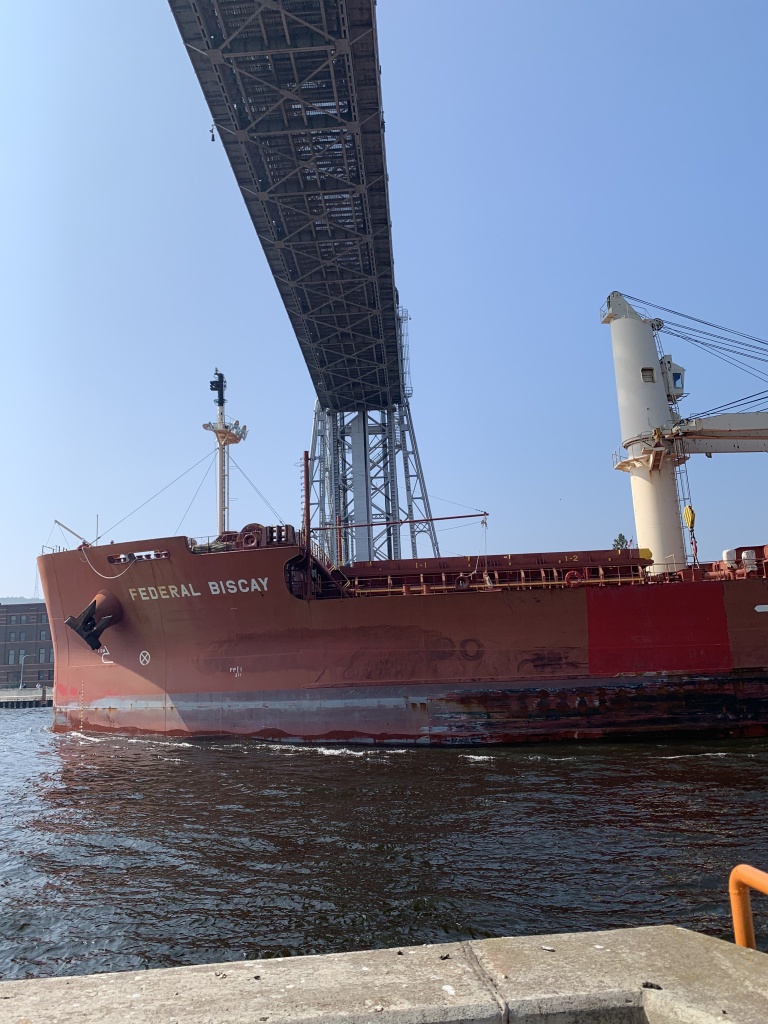

The next day, Team Zaaga’igan started working on what Nate Johnson’s lab refers to as the farm. Once we arrived, we were introduced to the mesocosms that contained wild rice. Our projects are still in the making, but wild rice is the main component for the themes of our research poster and story map. The data collections came from water samples contained in an apparatus designed in the Johnson lab called a peeper.


The peeper has a porous membrane meant to collect water into four different wells for each different layer of water and/or sediment from the mesocosm. While collecting the water samples from the peeper, a syringe is used and extracts the water while the peeper sits in a bag filled with nitrogen gas. The nitrogen gas helps keep the water in the peepers from becoming exposed to oxygen (maintains the water in an anoxic state). From these wells of water, we gathered information on sulfate, sulfide, and iron.


Later we used these samples of water to further record values on the absorbance of iron and sulfide from a spectrophotometer. The purpose for collecting this data is to help us practice the process and procedure our mentor’s lab uses for their experiments.
It was an exciting but busy time to enter into the lab, but after all this we have a much clearer idea of the data we’ll be working with. We’re now planning a project related to finding the relationship between the activity of certain contaminants and the speed of rejuvenation for the wild rice.

Hi all, my name’s Aidan! I’m a rising junior at Macalester College where I’m majoring in Environmental Studies with an emphasis on urban sustainability, and minoring in GIS/Cartography and Spanish. When I’m pulled away from studying topics in urban ecology, I enjoy playing (and coaching) tennis, hiking, cooking/baking, and watercolor painting. I’m super excited to join Team Stream this summer to conduct meaningful research!
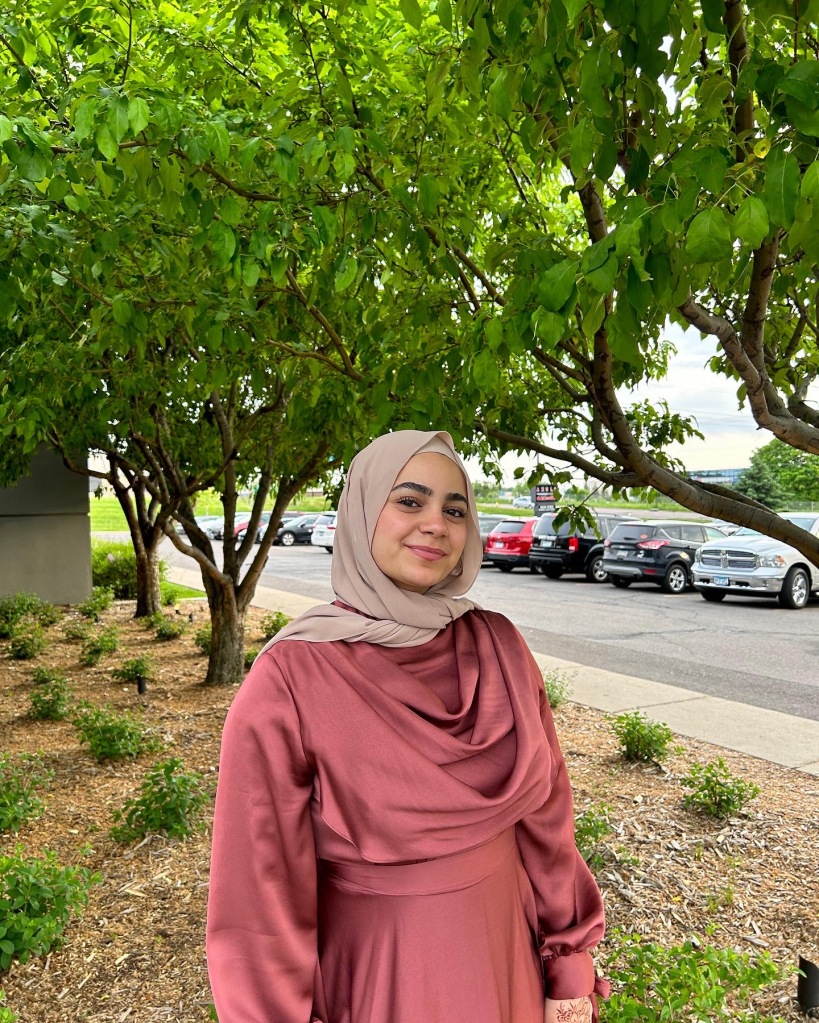
Salam Alaikum, my name is Summer Omar, and I am an Arab Muslim. I was born and raised in Fridley, Minnesota, with my three siblings and my cat. I am a rising senior at the University of Minnesota Rochester, majoring in health science as a pre-medical student. I have been on the board of the Muslim Student Association, and I was a Teacher Assistant for Chemistry. I have always been interested in research, and I am grateful that this summer, I am able to explore it more. I am excited to be a part of Team Stream – Urban Nature Group, where I will be able to connect with my peers and learn about research!

Hello there! My name is Travis Klein, and I’m a native of Midlothian, TX. I’m currently a rising junior at Oklahoma State University. I’m a Geology major with an interest in hydrogeology and reflection seismography. In my free time I love to go hiking, fishing, and kayaking. As a Texas sports enthusiast, I avidly follow the Houston Astros and other regional teams. I am grateful to be a part of Team Stream at SAFL, where I can further develop my research skills and harness the power of science to make a positive impact on local communities.
Hey everyone! My name’s Frankie Mele and I’m from Wrightwood, CA. I’m a rising senior at UCLA studying Environmental Science with a concentration in Conservation Biology. I am beyond excited to be a part of this year’s REU and get more experience doing research in urban ecology. Some of my favorite things to do in my free time include climbing, hiking and fishing!
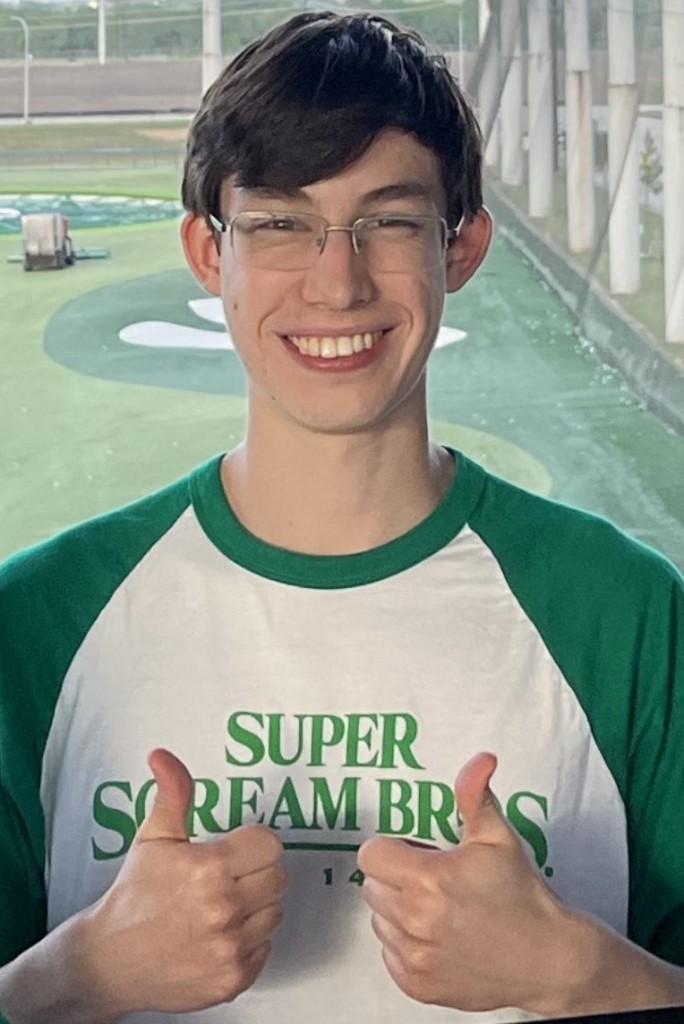
Hello! My name is Zach Jalley. As of writing, I am a geology student at the University of Illinois Urbana-Champaign. I grew up not far away from my place of study in the city of Decatur, Illinois, surrounded by both the culture of the Midwest and that of my Vietnamese father.
Currently, I am a part of the beekeeping club and honors student council at my university, and serve the Super SCREAM Bros. robotics team as an alumni mentor. Otherwise, some other things I enjoy in my free time are hiking, watching baseball, listening to music in the car, collecting soda bottles, and a video game series based around a pink, squishy, puffball named Kirby.
I’m very thankful to be a part of the experience, as it is a great way for me to develop my interest and research skills relating to the field of natural resource management, while also meeting all sorts of new and interesting people along the way!
After a bittersweet goodbye while closing out the All-Team Orientation in Glacier National Park, Team SPAW had an exciting week of project development! Our first field day was Wednesday where we visited the Jocko Valley Cemetery and met with members of the Tribal Cemetery Committee in order to plan our Ground Penetrating Radar project.
After the cemetery, we visited the wasteway field site for the wetlands remediation project and then took a trip to the Bison Range across the street.
On Thursday we had a phone call with THE Mark Lorang, the mentor for the wetlands projects and discussed the overall project details. Whilst sharpening our saw, one of our cohort members learned how to ride a bike while another researched effective methods and came up with the tagline, “Learning a life skill: Sharpening your saw,” story map to come. Tomorrow we are heading back to the cemetery for data collection to be followed by work on our abstracts and outlines in the afternoon. Stay tuned to hear more of Team SPAW’s summer adventures. Don’t forget to smash that like button and hit subscribe.

Hello everyone!
My name is Sylvie Alexander, and I was raised in Washington, DC. This coming fall I will be a rising sophomore at The Pennsylvania State University and will continue to major in Environmental Resource Management (ERM). I enjoy being outside – hiking, gardening, reading, aquatic sports, photography and anything with culinary arts. I will be on team SPAW this REU 2023 and I am so honored to be working with everyone involved with SLAWR.

𐒹𐒰𐓏𐒷! I am an Osage and Cherokee Native from Oklahoma. I will be a senior this fall at Colorado School of Mines studying Geological Engineering. I am incredibly passionate about equitable access to clean water, scientific communication, and native-lead initiatives. I enjoy reading, hiking, skiing, camping, or basically any excuse to be outdoors in my free time. I look forward to working with team SPAW this summer and spending some quality time in the wetlands here!

Hello, my name is Tay Porro. I am from Plainfield, Illinois and go to school at the University of Illinois at Chicago (UIC). I am a biochemistry major and will be a senior this upcoming fall semester. In my free time I enjoy playing games with people, going on runs, reading, and listening to a variety of music. I have a desire for learning about the environment because of how important it is to maintain for the future. I am so grateful to be a part of this opportunity; it aligns with my personal interests and career goals. I look forward to working on Team Zaaga’igan this summer and gaining as much field experience I can. This program has so much potential, and I want to make the most I can out of it.

Aaniin! I am a senior studying for a double major in Environmental Science and Native American and Indigenous Studies at the University of Minnesota- Morris. I am from Shoreview in the Twin Cities area, although my family is from White Earth, MN and Michoacán/Morelos, Mexico. At college I enjoy being on the Cheerleading Team, serving as the ESci Student Representative and working on sustainability related projects. In my free time, I love to watch movies, sew, camp, dance (Latin and swing), and play video games. I am looking forward to building relationships and practicing valuable Indigenous research skills with my mentors and peers this summer!

Boozhoo! My name is Saheli Patel and I am from Minneapolis, MN. I am Gujarati Indian and Turtle Mountain Ojibwe and I grew up on the Belcourt (North Dakota) and Sisseton (South Dakota) reservations. I am a rising junior and geology major at Carleton College and I enjoy hiking, playing soccer, reading, bouldering, and teaching myself various art forms including shrinky dink earring making, relief printmaking, and watercolor painting. Through this research experience I hope to strengthen my lab and field based research skills and to gain understanding of how to be a part of community-based participatory research.
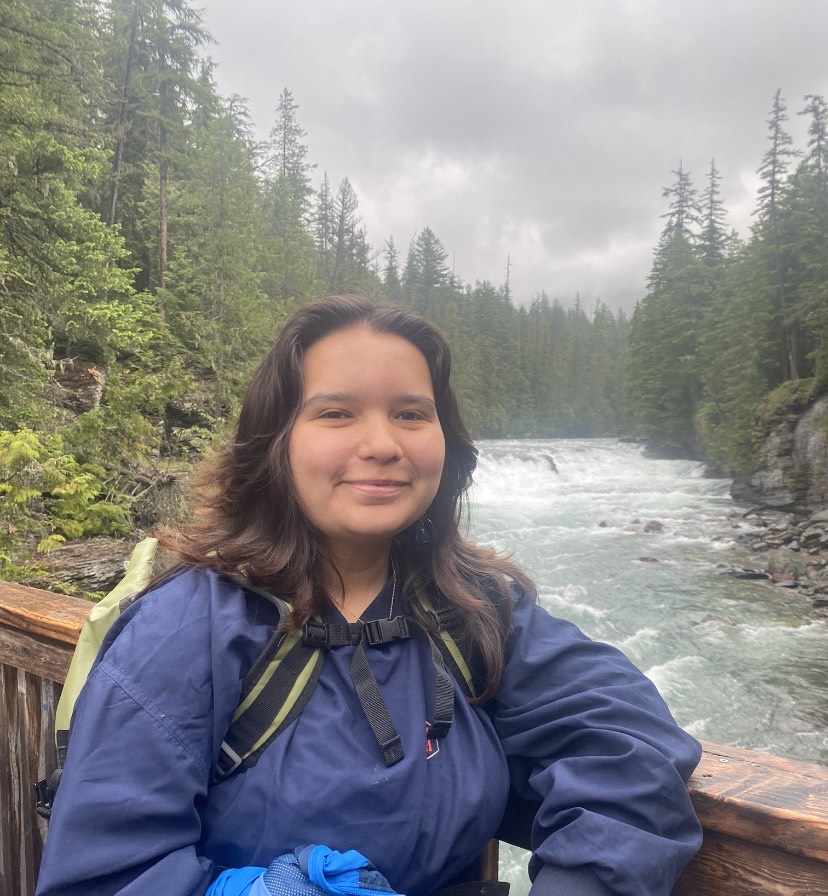
Hey y’all! I am from Houston, TX and I am currently a rising senior and geoscience major at Wellesley College. I am deeply passionate about environmental health, accessible science communication and community-oriented science. In my free time I love to go on nature walks, listen to music, and hangout with friends. I am so excited to work with Team SPAW this summer in beautiful Pablo, Montana!

The SPAW is proud to announce this year’s team logo. The logo represents each of the team member’s projects. Although each project is distinct, they are all unified under the topic of the SLAWR REU. Top left to bottom right; Erin’s research on wetlands, Noah’s research on evapotransportation, Logan’s research on Yellow-billed Cuckoos, and lastly Phil’s research on lake wind currents.
This past week the SPAW Team has been hard at work conducting fieldwork and collecting data. Although, Phil and Noah’s research does not require fieldwork, each will pair off with Logan and Erin to aid in their projects’ fieldwork. Phil and Erin went out to collect core samples from wetlands, while Noah and Logan began ground-truthing and bird calling for the Yellow-billed Cuckoo. Despite the long hours of fieldwork this past week the SPAW Team was able to take some time and hang out together enjoying the Montana weather. They flew Noah’s drone and took TEAM SPAW pictures and had fun taking videos.
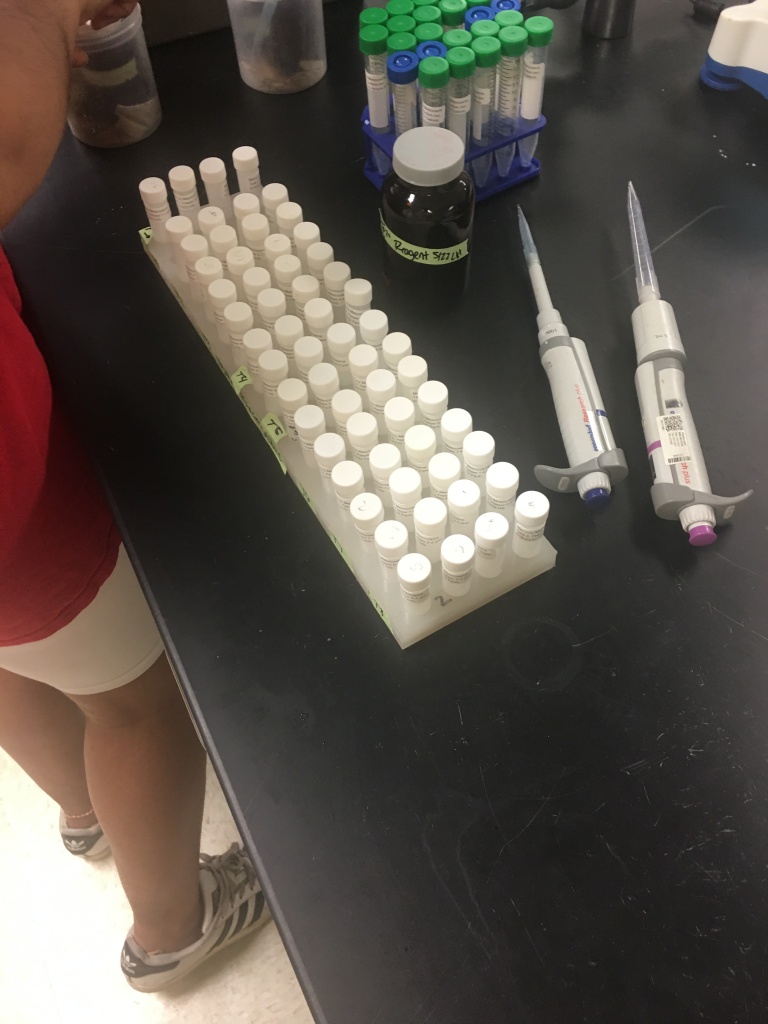
This week involved analyzing the data from the UMD farm from the previous week. Vials of surface water in the rice tanks and ‘peeper’ water that was soaked in the plants’ roots were all measured. Weight, pH, and changes in color were all recorded. This was good experience for me to learn laboratory skills in sampling and recording.
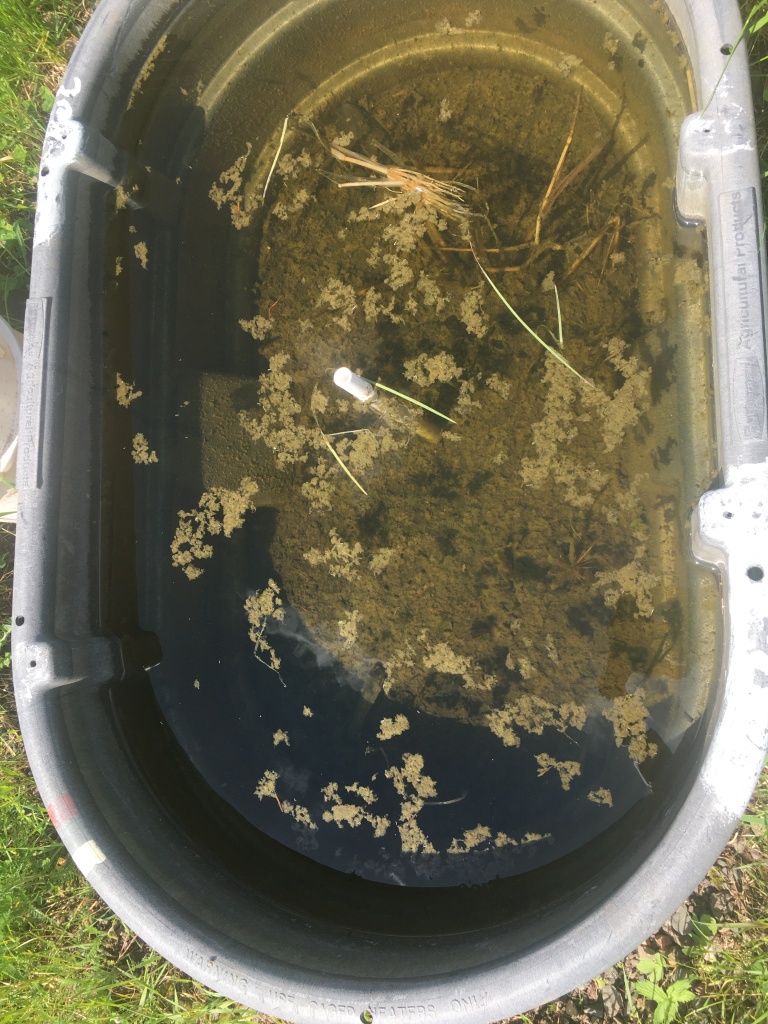
At the farm, our team measured plant count in the many wild rice tanks. These are controlled for sulfate by measured sulfate being pumped into the surface water of tanks. Bacteria that typically coexist with wild rice also live in the tanks; they fix the sulfate into sulfide which permeates into the water and is lethal to wild rice.
This week the Duluth team collected peepers from the mesocosms and extracted the water from the wells to test sulfate and iron concentration along with the pH. The data was taken to the lab where we checked the absorbance of the iron and sulfate and calculated how much sulfate needs to be added to the mesocosms.
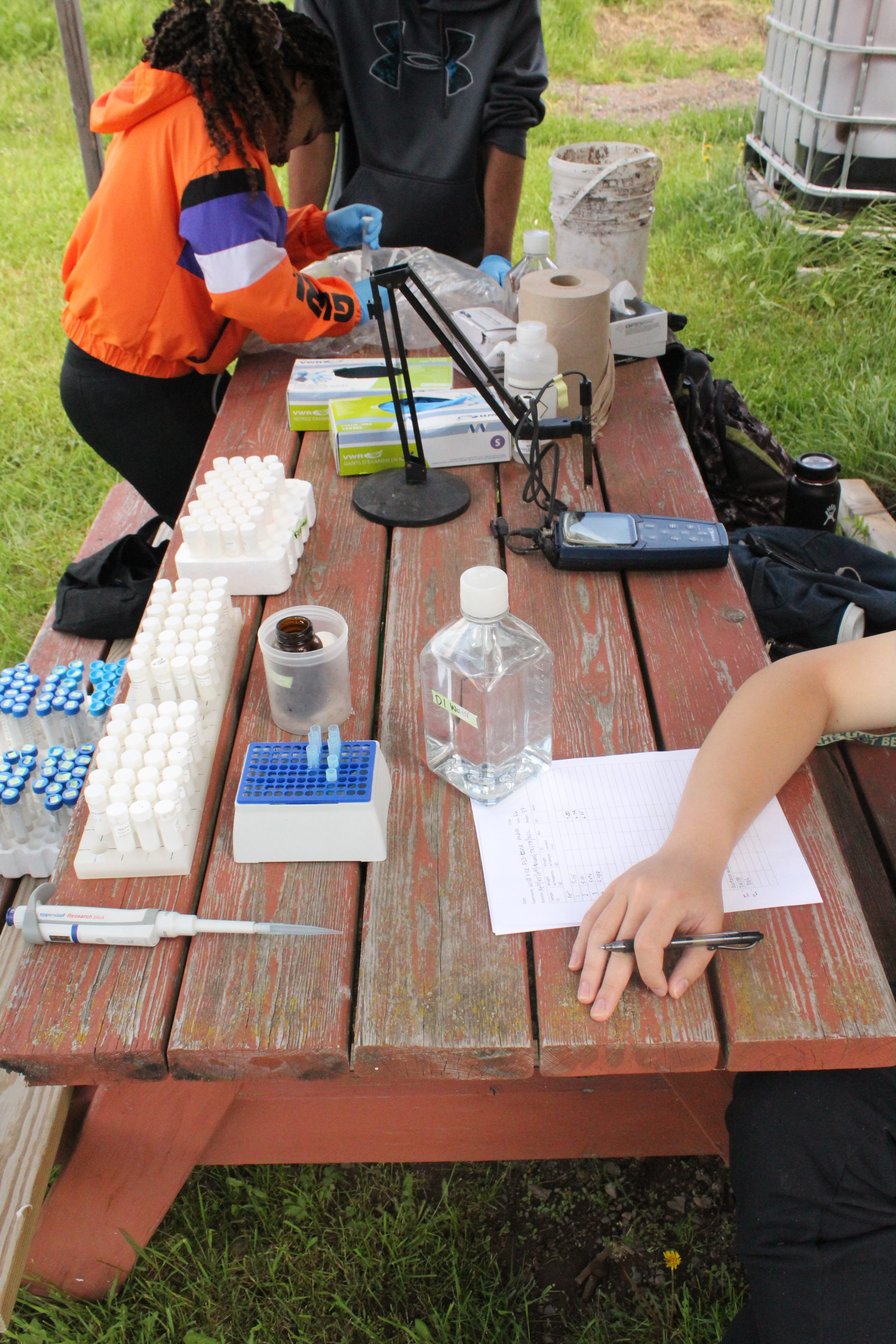


To the left is the team collecting the water from the wells of the peeper to test sulfate and iron concentrations. The middle picture is the peeper with four wells. Each well had porewater that needed to be tested. The right picture is the mesocosm which holds a controlled system for the wild rice plants.
This week I got to learn some new skills and tools! I went to Bruce Vento Nature Preserve (also known as Wakan Tipi) with some other members of my lab. Katie Hoffman, the Laboratory Manager, taught me how to use a Hach Portable Dissolved Oxygen and Conductivity probe meter for taking water quality data. I also learned how to filter water samples for carbon, nitrogen, hydrogen, chlorophyll a, and particulate phosphorus in the lab. I think these skills will be useful when trying to measure the health of aquatic ecosystems!

This week we accompanied researcher Rebekah Brassfield, aiding her with bumble bee work. We observed fly-bys, and flower visitation by bumblebees, as well as noting wind, humidity, temperature, and flower species abundance.
Her field sites are on tribal land, stewarded by Confederated Salish + Kootenai Tribes, filled with beautiful wildflowers and wide views of this valley, about 3,600 ft elevation.
Her sites are located in the trails above Jette – a housing development that moved from tribal homelands, into “owned” allotments, via the Dawes General Allotment Act (1887), followed by the Flathead Allotment Act (1904). This moved tribal land into settler ownership, effectively, “breaking up of communal tribal homelands and setting a course for catastrophic land loss on reservations.”
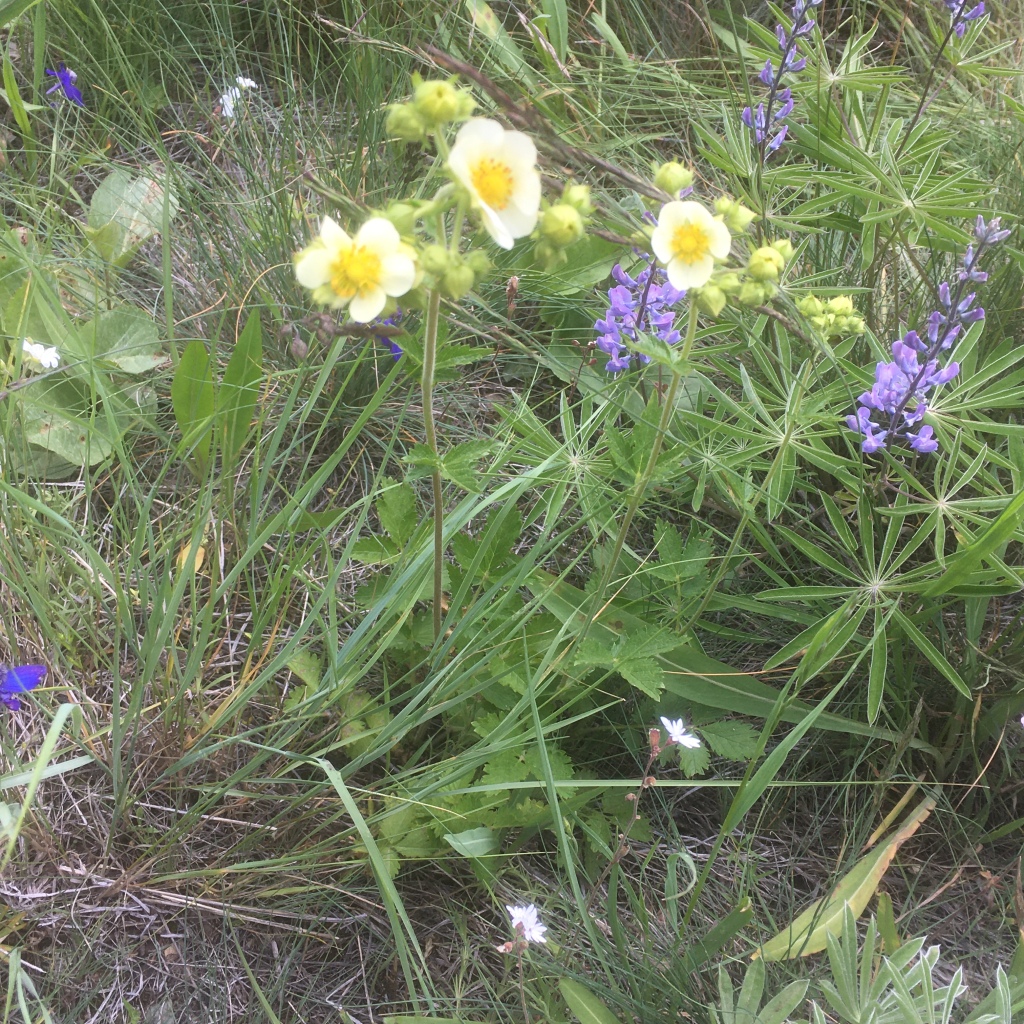
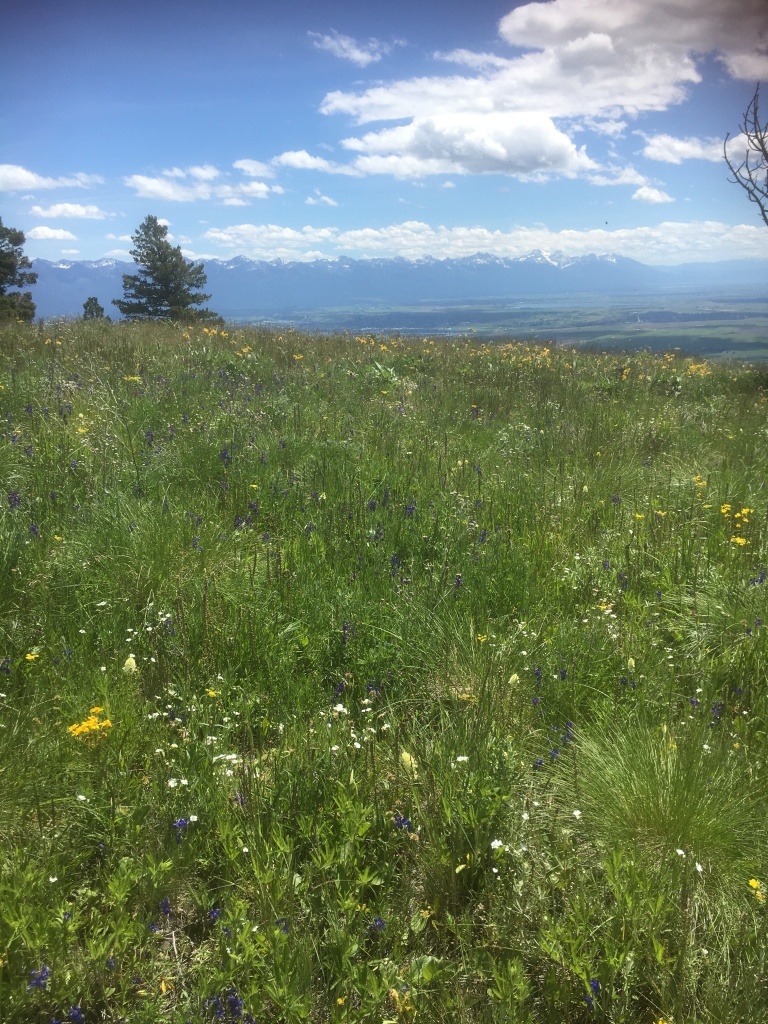
Meanwhile,
Noah found that his research question regarding evapotransportation rates correlated with wind has essentially been answered already. He deftly pivoted, now working on climate change effects correlated with evapotransportation.
Philip has been developing his R skills, as well as analyzing wind data. His work is moving along smoothly, investigating relationships between wind and lake shore erosion in the [East Side/Finley Point/Finley’s Armpit].
Logan continues his work, analyzing GIS layers, working towards building a habitat suitability model for Yellow-billed Cuckoo. He anticipates going to groundtruth with one of our mentors, this Friday. He is concerned about the complexity of the modeling in his research.
erinbell has been hanging on the edge of her seat, waiting to hear when and where she will be able to gather soil sampling for her project with wetlands and carbon sequestration. She remains excited, and has just found that she will be able to do her first field day this Friday.
Also, we had a bbq and it was sooooooo nice!



REU Sustainable Water and Land Resources
Monday training activity with group

